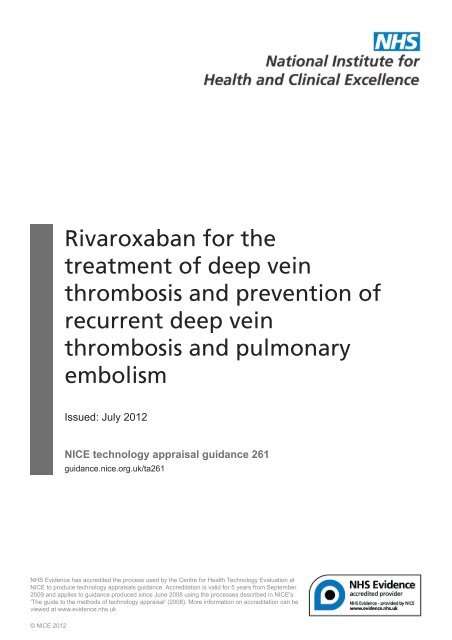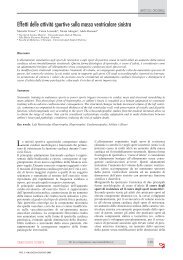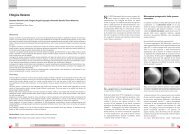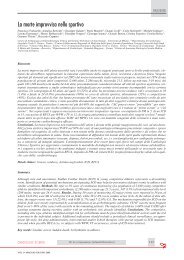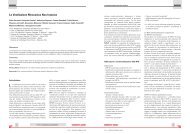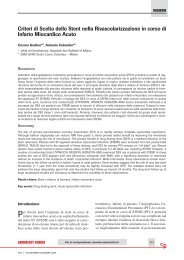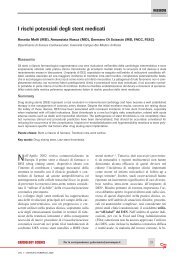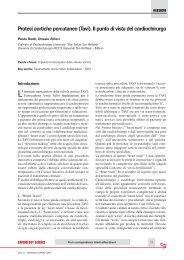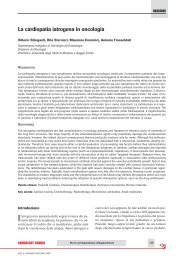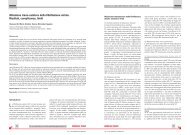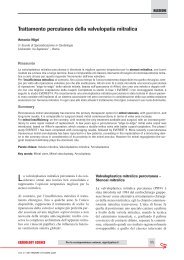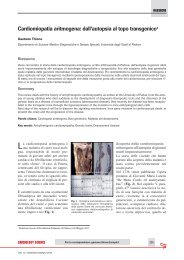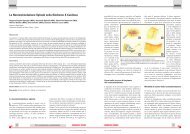Rivaroxaban for the treatment of deep vein thrombosis - National ...
Rivaroxaban for the treatment of deep vein thrombosis - National ...
Rivaroxaban for the treatment of deep vein thrombosis - National ...
Create successful ePaper yourself
Turn your PDF publications into a flip-book with our unique Google optimized e-Paper software.
<strong>Rivaroxaban</strong> <strong>for</strong> <strong>the</strong><br />
<strong>treatment</strong> <strong>of</strong> <strong>deep</strong> <strong>vein</strong><br />
<strong>thrombosis</strong> and prevention <strong>of</strong><br />
recurrent <strong>deep</strong> <strong>vein</strong><br />
<strong>thrombosis</strong> and pulmonary<br />
embolism<br />
Issued: July 2012<br />
NICE technology appraisal guidance 261<br />
guidance.nice.org.uk/ta261<br />
NHS Evidence has accredited <strong>the</strong> process used by <strong>the</strong> Centre <strong>for</strong> Health Technology Evaluation at<br />
NICE to produce technology appraisals guidance. Accreditation is valid <strong>for</strong> 5 years from September<br />
2009 and applies to guidance produced since June 2008 using <strong>the</strong> processes described in NICE's<br />
'The guide to <strong>the</strong> methods <strong>of</strong> technology appraisal' (2008). More in<strong>for</strong>mation on accreditation can be<br />
viewed at www.evidence.nhs.uk<br />
© NICE 2012
<strong>Rivaroxaban</strong> <strong>for</strong> <strong>the</strong> <strong>treatment</strong> <strong>of</strong> <strong>deep</strong> <strong>vein</strong> <strong>thrombosis</strong> and<br />
prevention <strong>of</strong> recurrent <strong>deep</strong> <strong>vein</strong> <strong>thrombosis</strong> and pulmonary<br />
embolism<br />
NICE technology<br />
appraisal guidance<br />
261<br />
Contents<br />
1 Guidance ................................................................................................................................. 3<br />
2 The technology ....................................................................................................................... 4<br />
3 The manufacturer's submission............................................................................................... 5<br />
Additional manufacturer analyses ......................................................................................................... 11<br />
4 Consideration <strong>of</strong> <strong>the</strong> evidence................................................................................................. 14<br />
Clinical effectiveness............................................................................................................................. 15<br />
Cost effectiveness ................................................................................................................................ 18<br />
Summary <strong>of</strong> Appraisal Committee's key conclusions............................................................................ 22<br />
5 Implementation........................................................................................................................ 29<br />
6 Recommendations <strong>for</strong> fur<strong>the</strong>r research .................................................................................. 30<br />
7 Related NICE guidance........................................................................................................... 31<br />
8 Review <strong>of</strong> guidance ................................................................................................................. 32<br />
Appendix A: Appraisal Committee members and NICE project team ........................................ 33<br />
A Appraisal Committee members.......................................................................................................... 33<br />
B Guideline representatives .................................................................................................................. 36<br />
C NICE project team ............................................................................................................................. 36<br />
Appendix B: Sources <strong>of</strong> evidence considered by <strong>the</strong> Committee............................................... 37<br />
About this guidance.................................................................................................................... 40<br />
© NICE 2012. All rights reserved. Last modified July 2012 Page 2 <strong>of</strong> 41
<strong>Rivaroxaban</strong> <strong>for</strong> <strong>the</strong> <strong>treatment</strong> <strong>of</strong> <strong>deep</strong> <strong>vein</strong> <strong>thrombosis</strong> and<br />
prevention <strong>of</strong> recurrent <strong>deep</strong> <strong>vein</strong> <strong>thrombosis</strong> and pulmonary<br />
embolism<br />
NICE technology<br />
appraisal guidance<br />
261<br />
1 Guidance<br />
1.1 <strong>Rivaroxaban</strong> is recommended as an option <strong>for</strong> treating <strong>deep</strong> <strong>vein</strong> <strong>thrombosis</strong><br />
and preventing recurrent <strong>deep</strong> <strong>vein</strong> <strong>thrombosis</strong> and pulmonary embolism after<br />
a diagnosis <strong>of</strong> acute <strong>deep</strong> <strong>vein</strong> <strong>thrombosis</strong> in adults.<br />
© NICE 2012. All rights reserved. Last modified July 2012 Page 3 <strong>of</strong> 41
<strong>Rivaroxaban</strong> <strong>for</strong> <strong>the</strong> <strong>treatment</strong> <strong>of</strong> <strong>deep</strong> <strong>vein</strong> <strong>thrombosis</strong> and<br />
prevention <strong>of</strong> recurrent <strong>deep</strong> <strong>vein</strong> <strong>thrombosis</strong> and pulmonary<br />
embolism<br />
NICE technology<br />
appraisal guidance<br />
261<br />
2 The technology<br />
2.1 <strong>Rivaroxaban</strong> (Xarelto, Bayer) is indicated <strong>for</strong> <strong>the</strong> '<strong>treatment</strong> <strong>of</strong> <strong>deep</strong> <strong>vein</strong><br />
<strong>thrombosis</strong> (DVT), and prevention <strong>of</strong> recurrent DVT and pulmonary embolism<br />
(PE) following an acute DVT in adults'. For <strong>the</strong> initial <strong>treatment</strong> <strong>of</strong> acute <strong>deep</strong><br />
<strong>vein</strong> <strong>thrombosis</strong>, <strong>the</strong> recommended dosage <strong>of</strong> rivaroxaban is 15 mg twice daily<br />
<strong>for</strong> <strong>the</strong> first 21 days followed by 20 mg once daily <strong>for</strong> continued <strong>treatment</strong> and<br />
prevention <strong>of</strong> recurrence.<br />
2.2 The duration <strong>of</strong> <strong>treatment</strong> recommended in <strong>the</strong> summary <strong>of</strong> product<br />
characteristics depends on bleeding risk and o<strong>the</strong>r clinical criteria: short-term<br />
<strong>treatment</strong> (3 months) is recommended <strong>for</strong> those with transient risk factors such<br />
as recent surgery and trauma, and longer <strong>treatment</strong> <strong>for</strong> permanent risk factors<br />
or idiopathic (unprovoked) <strong>deep</strong> <strong>vein</strong> <strong>thrombosis</strong>. The summary <strong>of</strong> product<br />
characteristics fur<strong>the</strong>r states that experience with rivaroxaban in this indication<br />
<strong>for</strong> more than 12 months is limited. A reduced dosage <strong>of</strong> 15 mg twice daily <strong>for</strong><br />
21 days followed by 15 mg once daily should be used in people with moderate<br />
(creatinine clearance 30–49 ml/min) or severe (creatinine clearance 15–29 ml/<br />
min) renal impairment. For full details <strong>of</strong> side effects and contraindications, see<br />
<strong>the</strong> summary <strong>of</strong> product characteristics.<br />
2.3 <strong>Rivaroxaban</strong> costs £2.10 per 15 mg or 20 mg tablet. The cost <strong>of</strong> <strong>treatment</strong> is<br />
estimated to be £235.86, £427.61 and £811.13 <strong>for</strong> 3, 6 and 12 months <strong>of</strong><br />
<strong>treatment</strong> respectively. Costs may vary in different settings because <strong>of</strong><br />
negotiated procurement discounts.<br />
© NICE 2012. All rights reserved. Last modified July 2012 Page 4 <strong>of</strong> 41
<strong>Rivaroxaban</strong> <strong>for</strong> <strong>the</strong> <strong>treatment</strong> <strong>of</strong> <strong>deep</strong> <strong>vein</strong> <strong>thrombosis</strong> and<br />
prevention <strong>of</strong> recurrent <strong>deep</strong> <strong>vein</strong> <strong>thrombosis</strong> and pulmonary<br />
embolism<br />
NICE technology<br />
appraisal guidance<br />
261<br />
3 The manufacturer's submission<br />
The Appraisal Committee (appendix A) considered evidence submitted by <strong>the</strong> manufacturer <strong>of</strong><br />
rivaroxaban and a review <strong>of</strong> this submission by <strong>the</strong> Evidence Review Group (ERG; appendix B).<br />
3.1 The key clinical evidence in <strong>the</strong> manufacturer's submission came from 2 trials<br />
(EINSTEIN-DVT and EINSTEIN-Ext). EINSTEIN-DVT was an open-label noninferiority<br />
study that compared rivaroxaban (15 mg twice daily <strong>for</strong> 3 weeks,<br />
<strong>the</strong>n 20 mg once daily <strong>for</strong> 3, 6 or 12 months) with enoxaparin followed by a<br />
vitamin K antagonist (ei<strong>the</strong>r warfarin or acenocoumarol) <strong>for</strong> treating patients<br />
with acute symptomatic <strong>deep</strong> <strong>vein</strong> <strong>thrombosis</strong> without any symptoms <strong>of</strong><br />
pulmonary embolism, and <strong>for</strong> preventing recurrent <strong>deep</strong> <strong>vein</strong> <strong>thrombosis</strong> and<br />
pulmonary embolism. Enoxaparin was given until a vitamin K antagonist had<br />
brought <strong>the</strong> international normalised ratio (INR) into <strong>the</strong> target range, and was<br />
<strong>the</strong>n stopped. Based on individual patient risk factors, patients were ei<strong>the</strong>r<br />
assigned to 3, 6 or 12 months <strong>of</strong> <strong>treatment</strong> as determined by <strong>the</strong> treating<br />
physician. EINSTEIN-Ext was a randomised placebo-controlled superiority trial<br />
that compared rivaroxaban (20 mg once daily; n=602) with placebo once daily<br />
(n=594) in patients with confirmed symptomatic <strong>deep</strong> <strong>vein</strong> <strong>thrombosis</strong> or<br />
pulmonary embolism that had been treated <strong>for</strong> 6 or 12 months with a vitamin K<br />
antagonist (warfarin or acenocoumarol) or rivaroxaban up to <strong>the</strong> moment <strong>of</strong><br />
randomisation. Patients were recruited if <strong>the</strong> risks and benefits <strong>of</strong> fur<strong>the</strong>r<br />
anticoagulation were finely balanced, that is, <strong>the</strong>re was 'clinical equipoise' <strong>for</strong><br />
<strong>the</strong> decision to continue anticoagulation.<br />
3.2 The manufacturer's submission noted that about 60% <strong>of</strong> patients recruited into<br />
EINSTEIN-Ext were assigned to 6 months <strong>of</strong> <strong>treatment</strong>, about 40% were<br />
assigned to 12 months <strong>of</strong> <strong>treatment</strong> and 28% had previously used rivaroxaban.<br />
The manufacturer also noted that some people were excluded from <strong>the</strong><br />
EINSTEIN-DVT and EINSTEIN-Ext trials, such as those with a creatinine<br />
clearance <strong>of</strong> less than 30 ml/min, clinically significant liver disease, high blood<br />
pressure (systolic more than 180 mmHg or diastolic more than 110 mmHg),<br />
active bleeding or at high risk <strong>of</strong> bleeding.<br />
3.3 The primary efficacy endpoint was a composite <strong>of</strong> <strong>deep</strong> <strong>vein</strong> <strong>thrombosis</strong> or<br />
pulmonary embolism (symptomatic, recurrent venous thromboembolism).<br />
© NICE 2012. All rights reserved. Last modified July 2012 Page 5 <strong>of</strong> 41
<strong>Rivaroxaban</strong> <strong>for</strong> <strong>the</strong> <strong>treatment</strong> <strong>of</strong> <strong>deep</strong> <strong>vein</strong> <strong>thrombosis</strong> and<br />
prevention <strong>of</strong> recurrent <strong>deep</strong> <strong>vein</strong> <strong>thrombosis</strong> and pulmonary<br />
embolism<br />
NICE technology<br />
appraisal guidance<br />
261<br />
Pulmonary embolism included both fatal and non-fatal pulmonary embolism.<br />
The primary safety endpoint was a composite <strong>of</strong> major bleeding and o<strong>the</strong>r<br />
clinically relevant non-major bleeding ('clinically relevant bleeding') <strong>for</strong><br />
EINSTEIN-DVT and major bleeding <strong>for</strong> EINSTEIN-Ext. A range <strong>of</strong> secondary<br />
composite endpoints were also included.<br />
3.4 In EINSTEIN-DVT, <strong>the</strong> primary efficacy endpoint <strong>of</strong> symptomatic recurrent<br />
venous thromboembolism occurred in 2.1% (n=36) <strong>of</strong> patients in <strong>the</strong><br />
rivaroxaban group compared with 3.0% (n=51) in <strong>the</strong> enoxaparin and vitamin K<br />
antagonist group (hazard ratio [HR] 0.68; 95% confidence interval [CI] 0.44 to<br />
1.04, p
<strong>Rivaroxaban</strong> <strong>for</strong> <strong>the</strong> <strong>treatment</strong> <strong>of</strong> <strong>deep</strong> <strong>vein</strong> <strong>thrombosis</strong> and<br />
prevention <strong>of</strong> recurrent <strong>deep</strong> <strong>vein</strong> <strong>thrombosis</strong> and pulmonary<br />
embolism<br />
NICE technology<br />
appraisal guidance<br />
261<br />
3.7 The manufacturer reported a mixed <strong>treatment</strong> comparison <strong>for</strong> <strong>the</strong> subgroup <strong>of</strong><br />
patients with cancer. This compared <strong>the</strong> relative effectiveness <strong>of</strong> rivaroxaban<br />
with dual low molecular weight heparin (LMWH) and a vitamin K antagonist,<br />
long-term LMWH compared with LMWH and a vitamin K antagonist, and<br />
rivaroxaban compared with long-term LMWH. The manufacturer provided 3<br />
analyses. The primary analysis used data from a systematic review <strong>of</strong> longterm<br />
anticoagulation in patients with cancer reported by Akl et al. (2011) and<br />
from <strong>the</strong> whole EINSTEIN-DVT trial population. Secondary analysis 1 used<br />
data from a trial by Lee et al. (2003) evaluating <strong>the</strong> LMWH dalteparin <strong>for</strong> <strong>the</strong><br />
prevention <strong>of</strong> recurrent venous thromboembolism in patients with cancer and<br />
<strong>the</strong> data from <strong>the</strong> whole EINSTEIN-DVT trial population. Similarly, secondary<br />
analysis 2 used data from Akl et al. (2011) and effectiveness data from <strong>the</strong><br />
cancer subgroup <strong>of</strong> EINSTEIN-DVT.<br />
3.8 Results from <strong>the</strong> primary analysis indicated that <strong>for</strong> patients with active cancer,<br />
<strong>the</strong> venous thromboembolism recurrence hazard ratio <strong>for</strong> rivaroxaban<br />
compared with long-term LMWH was 1.44 (95% credible intervals 0.07 to<br />
31.4). Secondary analysis 2 showed that rivaroxaban was less effective than<br />
LMWH at preventing venous thromboembolism recurrence (HR 1.32, 95%<br />
credible intervals 0.06 to 32.3) but induced fewer major bleeding events (odds<br />
ratio 0.24, 95% credible intervals 0.00 to 9.44). However, <strong>the</strong> manufacturer<br />
noted that <strong>the</strong> mixed <strong>treatment</strong> comparison had credible intervals with wide<br />
margins <strong>for</strong> <strong>the</strong> efficacy and safety <strong>of</strong> rivaroxaban compared with long-term<br />
LMWH.<br />
3.9 The manufacturer reported adverse events from EINSTEIN-DVT and<br />
EINSTEIN-Ext that were experienced in at least 4% <strong>of</strong> any <strong>treatment</strong> group.<br />
The most common adverse events across both EINSTEIN trials were<br />
headache, pain in extremity, nasopharyngitis and nosebleed. The reported<br />
incidences <strong>of</strong> post-thrombotic syndrome and chronic thromboembolic<br />
pulmonary hypertension were low in both arms <strong>of</strong> EINSTEIN-DVT and<br />
EINSTEIN-Ext.<br />
3.10 The manufacturer's submission used a Markov-based model <strong>for</strong> <strong>the</strong> economic<br />
evaluation <strong>of</strong> rivaroxaban within its licensed indication <strong>for</strong> treating <strong>deep</strong> <strong>vein</strong><br />
<strong>thrombosis</strong> and preventing recurrent thromboembolic events. Two analyses<br />
© NICE 2012. All rights reserved. Last modified July 2012 Page 7 <strong>of</strong> 41
<strong>Rivaroxaban</strong> <strong>for</strong> <strong>the</strong> <strong>treatment</strong> <strong>of</strong> <strong>deep</strong> <strong>vein</strong> <strong>thrombosis</strong> and<br />
prevention <strong>of</strong> recurrent <strong>deep</strong> <strong>vein</strong> <strong>thrombosis</strong> and pulmonary<br />
embolism<br />
NICE technology<br />
appraisal guidance<br />
261<br />
were presented: a primary analysis comparing rivaroxaban with LMWH and a<br />
vitamin K antagonist over 3, 6 and 12 months, and a cost-minimisation<br />
analysis <strong>for</strong> patients with active cancer, which used dalteparin (a LMWH) as<br />
<strong>the</strong> comparator. The manufacturer also presented a fur<strong>the</strong>r exploratory costeffectiveness<br />
analysis <strong>for</strong> patients with active cancer at <strong>the</strong> request <strong>of</strong> <strong>the</strong><br />
ERG.<br />
3.11 The Markov model comprised 11 health and <strong>treatment</strong> states and patients<br />
entered <strong>the</strong> model after a diagnosis <strong>of</strong> <strong>deep</strong> <strong>vein</strong> <strong>thrombosis</strong>. The model relied<br />
on <strong>the</strong> control arm <strong>of</strong> EINSTEIN-DVT to derive <strong>the</strong> probabilities <strong>of</strong> recurrent<br />
venous thromboembolism, bleeding and discontinuation rates. The<br />
probabilities in <strong>the</strong> rivaroxaban arm were calculated by applying <strong>the</strong><br />
appropriate hazard ratio or risk ratio to <strong>the</strong> probability in <strong>the</strong> control arm. The<br />
3-month discontinuation rate was assumed to be 1.9%. Probabilities <strong>for</strong> longterm<br />
complications and risk <strong>of</strong> mortality were taken from both EINSTEIN-DVT<br />
and literature reviews. Drug and resource costs were derived from relevant UK<br />
sources ('British national <strong>for</strong>mulary' [BNF], NHS Reference Costs 2009–10 and<br />
Personal Social Services Research Unit [PSSRU] 2010) and generally<br />
reflected UK clinical practice. The model did not include monitoring <strong>for</strong> patients<br />
treated with rivaroxaban or LMWH. It assumed 9 visits in <strong>the</strong> first 3 months,<br />
followed by 5 visits <strong>the</strong>reafter (every 3 months) <strong>for</strong> patients treated with a<br />
vitamin K antagonist. It also assumed that 66% <strong>of</strong> visits <strong>for</strong> INR monitoring<br />
would take place in primary care and 34% in secondary care. For primary care,<br />
<strong>the</strong> manufacturer assumed INR monitoring would be delivered equally by a GP<br />
and a nurse (50/50 split). The estimated annual cost <strong>of</strong> INR monitoring,<br />
including transport costs, was £656 in <strong>the</strong> first year and £540 <strong>the</strong>reafter.<br />
3.12 A validated preference-based measure <strong>of</strong> quality <strong>of</strong> life was not used in <strong>the</strong><br />
EINSTEIN-DVT trial, so <strong>the</strong> economic model submitted by <strong>the</strong> manufacturer<br />
used utility values sourced from literature reviews. The manufacturer assigned<br />
a baseline utility value <strong>of</strong> 0.825 to all patients with <strong>deep</strong> <strong>vein</strong> <strong>thrombosis</strong><br />
entering <strong>the</strong> model, which was taken from a survey <strong>of</strong> <strong>the</strong> UK general<br />
population using a visual analogue scale rating (Kind et al. 1998) and adjusted<br />
with disutility values <strong>for</strong> <strong>deep</strong> <strong>vein</strong> <strong>thrombosis</strong>, pulmonary embolism,<br />
extracranial bleed, intracranial bleed and post-thrombotic syndrome.<br />
© NICE 2012. All rights reserved. Last modified July 2012 Page 8 <strong>of</strong> 41
<strong>Rivaroxaban</strong> <strong>for</strong> <strong>the</strong> <strong>treatment</strong> <strong>of</strong> <strong>deep</strong> <strong>vein</strong> <strong>thrombosis</strong> and<br />
prevention <strong>of</strong> recurrent <strong>deep</strong> <strong>vein</strong> <strong>thrombosis</strong> and pulmonary<br />
embolism<br />
NICE technology<br />
appraisal guidance<br />
261<br />
3.13 The base-case results included all <strong>the</strong> drug acquisition costs, resources<br />
associated with monitoring, and costs associated with adverse events (that is,<br />
bleeding events) and were presented by intended <strong>treatment</strong> durations (3, 6<br />
and 12 months). Treatment with rivaroxaban dominated <strong>treatment</strong> with LMWH<br />
and a vitamin K antagonist across all <strong>treatment</strong> durations, that is, rivaroxaban<br />
was less costly and more effective compared with LMWH and a vitamin K<br />
antagonist (0.02 incremental QALYs <strong>for</strong> all <strong>treatment</strong> durations and cost<br />
savings <strong>of</strong> £163 at 3 months, £124 at 6 months and £33 at 12 months).<br />
3.14 The manufacturer undertook a series <strong>of</strong> univariate and multivariate<br />
deterministic sensitivity analyses to test <strong>the</strong> robustness <strong>of</strong> <strong>the</strong> results by<br />
varying most <strong>of</strong> <strong>the</strong> parameters used in <strong>the</strong> economic evaluation. The results<br />
were generally sensitive to <strong>the</strong> cost <strong>of</strong> monitoring and <strong>the</strong> hazard ratio <strong>for</strong><br />
venous thromboembolism. The manufacturer also provided probabilistic<br />
sensitivity analyses. These showed that <strong>the</strong>re was a 94.2–98.9% probability <strong>of</strong><br />
rivaroxaban being cost effective at £20,000 per QALY gained <strong>for</strong> all <strong>treatment</strong><br />
durations. The <strong>treatment</strong> duration <strong>of</strong> 3 months produced <strong>the</strong> most cost savings<br />
and increased incremental QALYs. The probability <strong>of</strong> rivaroxaban being <strong>the</strong><br />
dominant <strong>treatment</strong> option was 97.1% in patients having 3 months <strong>of</strong><br />
anticoagulation, 83.9% in those having 6 months and 53.0% in those having<br />
12 months.<br />
3.15 The manufacturer presented a cost minimisation analysis evaluating<br />
rivaroxaban in patients with cancer. Patients with cancer were assumed to be<br />
treated <strong>for</strong> 6 months. The cost <strong>of</strong> rivaroxaban was £4.20 per day <strong>for</strong> <strong>the</strong> first<br />
21 days (2 tablets daily), followed by £2.10 per day (1 tablet daily). The cost <strong>of</strong><br />
dalteparin was £8.47 per day <strong>for</strong> <strong>the</strong> first month and £7.06 per day <strong>for</strong><br />
subsequent months. The total cost saving associated with rivaroxaban<br />
compared with LMWH (dalteparin) was £903 <strong>for</strong> patients with cancer.<br />
3.16 The manufacturer also presented an exploratory cost-effectiveness analysis <strong>of</strong><br />
<strong>the</strong> subgroup <strong>of</strong> patients with cancer. Using <strong>treatment</strong> effects from <strong>the</strong> mixed<br />
<strong>treatment</strong> comparison, assuming no INR monitoring cost and using a 6-month<br />
<strong>treatment</strong> duration, rivaroxaban dominated dalteparin (0.0013 incremental<br />
QALYs and cost savings <strong>of</strong> £1085).<br />
© NICE 2012. All rights reserved. Last modified July 2012 Page 9 <strong>of</strong> 41
<strong>Rivaroxaban</strong> <strong>for</strong> <strong>the</strong> <strong>treatment</strong> <strong>of</strong> <strong>deep</strong> <strong>vein</strong> <strong>thrombosis</strong> and<br />
prevention <strong>of</strong> recurrent <strong>deep</strong> <strong>vein</strong> <strong>thrombosis</strong> and pulmonary<br />
embolism<br />
NICE technology<br />
appraisal guidance<br />
261<br />
3.17 The ERG raised concerns about <strong>the</strong> applicability <strong>of</strong> <strong>the</strong> EINSTEIN trials to UK<br />
clinical practice, including that <strong>the</strong> trials did not fully reflect <strong>the</strong> UK population<br />
with <strong>deep</strong> <strong>vein</strong> <strong>thrombosis</strong> because a number <strong>of</strong> important patient groups were<br />
excluded from both trials. These included patients with high risk <strong>of</strong> bleeding,<br />
creatinine clearance less than 30 ml/min (but not less than 15 ml/min),<br />
clinically significant liver disease, high blood pressure (systolic more<br />
than 180 mmHg or diastolic more than 110 mmHg) and non-proximal <strong>deep</strong> <strong>vein</strong><br />
<strong>thrombosis</strong>. Specifically, <strong>the</strong> ERG noted that <strong>the</strong>re are no data to in<strong>for</strong>m<br />
decisions about patients with increased risk <strong>of</strong> bleeding. The ERG also noted<br />
that <strong>the</strong> EINSTEIN trials did not include patients <strong>for</strong> whom vitamin K<br />
antagonists are not appropriate, o<strong>the</strong>r than patients with cancer. It noted <strong>the</strong><br />
population recruited into <strong>the</strong> EINSTEIN trials excluded a number <strong>of</strong> important<br />
groups relevant to <strong>the</strong> decision problem.<br />
3.18 The ERG and its clinical advisers considered <strong>the</strong> comparator (enoxaparin)<br />
used by <strong>the</strong> manufacturer to be appropriate, although <strong>the</strong> dosage used in <strong>the</strong><br />
EINSTEIN trials (1 mg/kg twice daily) was not in line with UK clinical practice<br />
(1.5 mg/kg once daily). Using <strong>the</strong> twice-daily dosage may have been<br />
unfavourable to rivaroxaban.<br />
3.19 The manufacturer assumed <strong>the</strong> maximum <strong>treatment</strong> duration was 12 months<br />
<strong>for</strong> idiopathic <strong>deep</strong> <strong>vein</strong> <strong>thrombosis</strong> or in <strong>the</strong> presence <strong>of</strong> permanent risk<br />
factors. However, <strong>the</strong> clinical advisers to <strong>the</strong> ERG questioned this assumption<br />
and stated that it is now common <strong>for</strong> <strong>treatment</strong> to extend beyond 12 months,<br />
depending on patient characteristics and risk factors. The ERG's clinical<br />
advisers estimated that around 20% <strong>of</strong> people with <strong>deep</strong> <strong>vein</strong> <strong>thrombosis</strong><br />
would have long-term <strong>treatment</strong> because <strong>of</strong> an ongoing risk <strong>of</strong> recurrence <strong>of</strong><br />
venous thromboembolism.<br />
3.20 The ERG raised concerns about <strong>the</strong> robustness <strong>of</strong> <strong>the</strong> mixed <strong>treatment</strong><br />
comparison in <strong>the</strong> cancer subgroup and <strong>the</strong> way <strong>the</strong> evidence was<br />
syn<strong>the</strong>sised. The ERG noted that <strong>the</strong> included trials varied in <strong>the</strong> length <strong>of</strong><br />
follow-up, and choice and dosage <strong>of</strong> LMWH also varied across studies. The<br />
ERG concluded that <strong>the</strong> mixed <strong>treatment</strong> comparison did not provide good<br />
estimates <strong>of</strong> <strong>the</strong> uncertainty associated with <strong>the</strong> true <strong>treatment</strong> effect, but found<br />
<strong>the</strong> point estimate to be reasonable.<br />
© NICE 2012. All rights reserved. Last modified July 2012 Page 10 <strong>of</strong> 41
<strong>Rivaroxaban</strong> <strong>for</strong> <strong>the</strong> <strong>treatment</strong> <strong>of</strong> <strong>deep</strong> <strong>vein</strong> <strong>thrombosis</strong> and<br />
prevention <strong>of</strong> recurrent <strong>deep</strong> <strong>vein</strong> <strong>thrombosis</strong> and pulmonary<br />
embolism<br />
NICE technology<br />
appraisal guidance<br />
261<br />
3.21 The ERG presented exploratory analyses that corrected certain errors in <strong>the</strong><br />
model and took into account a less intensive INR monitoring strategy<br />
comprising 6 INR monitoring visits in <strong>the</strong> first 3 months and 3 visits every<br />
3 months <strong>the</strong>reafter. The results indicated that enoxaparin and a vitamin K<br />
antagonist were dominated by rivaroxaban <strong>for</strong> <strong>the</strong> 3-month duration group<br />
(0.02 incremental QALYs and a cost saving <strong>of</strong> £51). Compared with<br />
enoxaparin and a vitamin K antagonist, <strong>the</strong> incremental cost-effectiveness ratio<br />
(ICER) <strong>of</strong> rivaroxaban was £3247 per QALY gained <strong>for</strong> <strong>the</strong> 6-month <strong>treatment</strong><br />
duration and £14,902 per QALY gained <strong>for</strong> <strong>the</strong> 12-month <strong>treatment</strong> duration.<br />
3.22 The ERG revised <strong>the</strong> manufacturer's exploratory analysis in cancer patients to<br />
take into account what it considered to be a more plausible – and smaller –<br />
distribution <strong>of</strong> between-study standard deviations (as opposed to <strong>the</strong><br />
alternative distributions used by <strong>the</strong> manufacturer). This found rivaroxaban to<br />
be less effective than LMWH at preventing venous thromboembolism<br />
recurrence. The ERG raised concerns with <strong>the</strong> limited evidence available in <strong>the</strong><br />
cancer subgroup, and with <strong>the</strong> modelling assumptions in <strong>the</strong> exploratory<br />
analysis. The ERG concluded any reliance on <strong>the</strong> results <strong>of</strong> <strong>the</strong> mixed<br />
<strong>treatment</strong> comparison may lead to inaccurate estimates <strong>of</strong> mean ICERs<br />
because <strong>the</strong>y are based on inflated expected values.<br />
Additional manufacturer analyses<br />
3.23 After consultation, <strong>the</strong> manufacturer submitted additional analyses on <strong>the</strong> cost<br />
effectiveness <strong>of</strong> rivaroxaban in people in whom long-term anticoagulation is<br />
intended; that is, people who need anticoagulation <strong>for</strong> longer than 12 months.<br />
The manufacturer also commented fur<strong>the</strong>r on <strong>the</strong> characteristics <strong>of</strong> patients in<br />
<strong>the</strong> 3, 6, and 12 month <strong>treatment</strong> duration groups in <strong>the</strong> EINSTEIN-DVT trial.<br />
3.24 The manufacturer's new economic model <strong>for</strong> long-term use <strong>of</strong> rivaroxaban<br />
used event rates <strong>for</strong> venous thromboembolism recurrence and bleeding from<br />
<strong>the</strong> 12-month duration group <strong>of</strong> EINSTEIN-DVT <strong>for</strong> people treated with a<br />
LMWH and a vitamin K antagonist. The long-term risk <strong>of</strong> venous<br />
thromboembolism recurrence (after 1 year) was taken from a meta-analysis<br />
review, and results from <strong>the</strong> whole trial population <strong>of</strong> EINSTEIN-DVT were<br />
used to estimate <strong>the</strong> <strong>treatment</strong> effects. The manufacturer presented 2<br />
© NICE 2012. All rights reserved. Last modified July 2012 Page 11 <strong>of</strong> 41
<strong>Rivaroxaban</strong> <strong>for</strong> <strong>the</strong> <strong>treatment</strong> <strong>of</strong> <strong>deep</strong> <strong>vein</strong> <strong>thrombosis</strong> and<br />
prevention <strong>of</strong> recurrent <strong>deep</strong> <strong>vein</strong> <strong>thrombosis</strong> and pulmonary<br />
embolism<br />
NICE technology<br />
appraisal guidance<br />
261<br />
scenarios. One took into account <strong>the</strong> manufacturer's assumed INR frequency<br />
<strong>of</strong> 9 visits in <strong>the</strong> first 3 months followed by 5 visits every 3 months <strong>the</strong>reafter<br />
(first-year costs £656). The o<strong>the</strong>r adopted a less intensive INR monitoring<br />
programme <strong>of</strong> 6 visits in <strong>the</strong> first 3 months followed by 3 visits every 3 months<br />
<strong>the</strong>reafter (first-year cost <strong>of</strong> £413). The model assumed a discontinuation rate<br />
<strong>of</strong> 3.6% every 3 months based on a review <strong>of</strong> long-term statin <strong>the</strong>rapy because<br />
evidence on adherence to rivaroxaban <strong>for</strong> longer than 12 months <strong>of</strong> <strong>treatment</strong><br />
was not available. The model also included a sensitivity analysis in which <strong>the</strong><br />
3-month discontinuation rate was varied from 1.9% to 6.9%.<br />
3.25 The model applied a disutility <strong>of</strong> 0.012 to warfarin, which was sourced from a<br />
study by Marchetti et al. (2001) involving a small group <strong>of</strong> patients (n=48)<br />
attending an anticoagulation clinic. The manufacturer noted that a disutility<br />
would not apply to rivaroxaban, citing reasons that included raised levels <strong>of</strong><br />
<strong>treatment</strong> satisfaction in comparison with LMWH and a vitamin K antagonist,<br />
and that no clinically important adverse events were associated with<br />
rivaroxaban that had not already been taken into account in <strong>the</strong> model. The<br />
manufacturer also referred to 'Dabigatran etexilate <strong>for</strong> <strong>the</strong> prevention <strong>of</strong> stroke<br />
and systemic embolism in atrial fibrillation' (NICE technology appraisal 249), in<br />
which a disutility was applied to dabigatran to account <strong>for</strong> dyspepsia, an<br />
adverse event not associated with rivaroxaban.<br />
3.26 The results from <strong>the</strong> long-term anticoagulation model showed that <strong>the</strong> ICER <strong>for</strong><br />
rivaroxaban compared with LMWH and a vitamin K antagonist was £6037 per<br />
QALY gained under <strong>the</strong> manufacturer's assumed INR monitoring cost <strong>of</strong> £656<br />
(0.16 incremental QALYs and additional cost <strong>of</strong> £953). Assuming a lower INR<br />
monitoring cost <strong>of</strong> £413, an ICER <strong>of</strong> £15,847 per QALY gained (0.16<br />
incremental QALYs and additional cost <strong>of</strong> £2502) was reported by <strong>the</strong><br />
manufacturer. The probabilistic sensitivity analysis based on reduced INR<br />
monitoring showed that <strong>the</strong>re was a 58% probability that rivaroxaban was cost<br />
effective at £20,000 per QALY gained and a 25% probability that rivaroxaban<br />
was dominant (more effective and less costly).<br />
3.27 The ERG was generally satisfied with <strong>the</strong> assumptions made in <strong>the</strong><br />
manufacturer's long-term economic model but noted that it is uncertain<br />
whe<strong>the</strong>r <strong>the</strong> <strong>treatment</strong> effects assumed in <strong>the</strong> model would remain fixed over a<br />
© NICE 2012. All rights reserved. Last modified July 2012 Page 12 <strong>of</strong> 41
<strong>Rivaroxaban</strong> <strong>for</strong> <strong>the</strong> <strong>treatment</strong> <strong>of</strong> <strong>deep</strong> <strong>vein</strong> <strong>thrombosis</strong> and<br />
prevention <strong>of</strong> recurrent <strong>deep</strong> <strong>vein</strong> <strong>thrombosis</strong> and pulmonary<br />
embolism<br />
NICE technology<br />
appraisal guidance<br />
261<br />
lifetime. The ERG explored several scenarios based on variations to <strong>the</strong><br />
manufacturer's long-term anticoagulation model:<br />
Assuming <strong>treatment</strong> effect from <strong>the</strong> whole trial population over a lifetime horizon.<br />
Assuming a lower INR cost <strong>of</strong> £320 <strong>for</strong> <strong>the</strong> first year followed by £248 annually<br />
<strong>the</strong>reafter, based on a reduced frequency <strong>of</strong> visits (6 visits in <strong>the</strong> first 3 months and<br />
<strong>the</strong>n 3 visits every 3 months <strong>the</strong>reafter with a different GP/nurse consultation ratio<br />
than <strong>the</strong> one used by <strong>the</strong> manufacturer).<br />
Varying <strong>the</strong> 3-month discontinuation rate <strong>for</strong> rivaroxaban from 3.6% as assumed in<br />
<strong>the</strong> manufacturer's long-term model to 1.9% as assumed by <strong>the</strong> manufacturer in <strong>the</strong><br />
original submission.<br />
Applying a 0.012 decrement in utility <strong>for</strong> warfarin and no decrement <strong>for</strong> rivaroxaban;<br />
0.012 decrement in utility <strong>for</strong> warfarin and 0.006 decrement in utility <strong>for</strong> rivaroxaban;<br />
and assuming no decrement in utility <strong>for</strong> both warfarin and rivaroxaban.<br />
Taking into account <strong>the</strong> above assumptions, <strong>the</strong> results from <strong>the</strong> ERG's exploratory analyses<br />
yielded ICERs ranging from £19,381 to £38,837 per QALY gained. A deterministic calculation<br />
based on a whole-trial <strong>treatment</strong> effect, <strong>the</strong> lower cost <strong>of</strong> INR monitoring, and a utility decrement<br />
<strong>for</strong> warfarin only, indicated an ICER <strong>of</strong> £19,381 per QALY gained, assuming <strong>the</strong> same 3-month<br />
discontinuation rate <strong>of</strong> 3.6% <strong>for</strong> warfarin and rivaroxaban. The equivalent ICER when <strong>the</strong><br />
discontinuation rate <strong>for</strong> rivaroxaban was lowered to 1.9%, while keeping <strong>the</strong> warfarin<br />
discontinuation rate at 3.6%, was £25,076 per QALY gained.<br />
3.28 Full details <strong>of</strong> all <strong>the</strong> evidence are in <strong>the</strong> manufacturer's submission and <strong>the</strong><br />
ERG report, which are available from www.nice.org.uk/guidance/TA261<br />
© NICE 2012. All rights reserved. Last modified July 2012 Page 13 <strong>of</strong> 41
<strong>Rivaroxaban</strong> <strong>for</strong> <strong>the</strong> <strong>treatment</strong> <strong>of</strong> <strong>deep</strong> <strong>vein</strong> <strong>thrombosis</strong> and<br />
prevention <strong>of</strong> recurrent <strong>deep</strong> <strong>vein</strong> <strong>thrombosis</strong> and pulmonary<br />
embolism<br />
NICE technology<br />
appraisal guidance<br />
261<br />
4 Consideration <strong>of</strong> <strong>the</strong> evidence<br />
4.1 The Appraisal Committee reviewed <strong>the</strong> data available on <strong>the</strong> clinical and cost<br />
effectiveness <strong>of</strong> rivaroxaban, having considered evidence on <strong>the</strong> nature <strong>of</strong><br />
venous thromboembolism and <strong>the</strong> value placed on <strong>the</strong> benefits <strong>of</strong> rivaroxaban<br />
by people with <strong>the</strong> condition, those who represent <strong>the</strong>m, and clinical<br />
specialists. It also took into account <strong>the</strong> effective use <strong>of</strong> NHS resources.<br />
4.2 The Committee heard from <strong>the</strong> clinical specialists that currently venous<br />
thromboembolism is initially treated with a LMWH (such as enoxaparin,<br />
dalteparin or tinzaparin) <strong>for</strong> rapid anticoagulation, overlapped with warfarin until<br />
an effective INR is achieved. The Committee also heard that <strong>treatment</strong><br />
duration is based on an assessment <strong>of</strong> <strong>the</strong> benefit <strong>of</strong> continued anticoagulation<br />
compared with <strong>the</strong> risk <strong>of</strong> bleeding. The clinical specialists stated that<br />
<strong>treatment</strong> is <strong>of</strong>ten started with an expected duration <strong>of</strong> <strong>the</strong>rapy, but that<br />
increasingly, a clinical re-evaluation is carried out at 3 or 6 months and a<br />
decision is made whe<strong>the</strong>r or not to continue <strong>the</strong>rapy. The clinical specialists<br />
stated that in current UK practice, most people receive anticoagulation<br />
<strong>treatment</strong> <strong>for</strong> 6 months, which corresponds to <strong>the</strong> largest group in <strong>the</strong><br />
EINSTEIN-DVT trial. However, <strong>the</strong> Committee heard that a NICE clinical<br />
guideline in development on venous thromboembolic diseases is expected to<br />
recommend anticoagulation <strong>for</strong> 3 months in people with transient risk factors<br />
<strong>for</strong> <strong>deep</strong> <strong>vein</strong> <strong>thrombosis</strong>, and to recommend longer-term <strong>treatment</strong> in people<br />
with permanent risk factors and unprovoked <strong>deep</strong> <strong>vein</strong> <strong>thrombosis</strong>, taking into<br />
account individual risk factors such as risk <strong>of</strong> bleeding. The Committee<br />
concluded that although 6 months is currently <strong>the</strong> commonest duration <strong>of</strong><br />
<strong>treatment</strong> in UK practice, this could change in light <strong>of</strong> <strong>the</strong> NICE clinical<br />
guideline on venous thromboembolic diseases.<br />
4.3 The Committee noted <strong>the</strong> written evidence from patient experts, which stated<br />
that many people find taking warfarin to be stressful, because <strong>of</strong> <strong>the</strong> necessary<br />
regular monitoring with blood tests, dosing adjustments, and because people<br />
must be careful about <strong>the</strong>ir diet because <strong>of</strong> warfarin's interaction with certain<br />
foods. The Committee heard from clinical specialists who agreed that warfarin<br />
is associated with a wide range <strong>of</strong> important and potentially dangerous drug<br />
interactions, and that warfarin can also negatively impact people's quality <strong>of</strong> life<br />
© NICE 2012. All rights reserved. Last modified July 2012 Page 14 <strong>of</strong> 41
<strong>Rivaroxaban</strong> <strong>for</strong> <strong>the</strong> <strong>treatment</strong> <strong>of</strong> <strong>deep</strong> <strong>vein</strong> <strong>thrombosis</strong> and<br />
prevention <strong>of</strong> recurrent <strong>deep</strong> <strong>vein</strong> <strong>thrombosis</strong> and pulmonary<br />
embolism<br />
NICE technology<br />
appraisal guidance<br />
261<br />
by preventing travel and o<strong>the</strong>r freedoms because <strong>of</strong> <strong>the</strong> need <strong>for</strong> regular<br />
monitoring. The Committee also heard from <strong>the</strong> patient experts that<br />
rivaroxaban may improve <strong>the</strong> quality <strong>of</strong> life <strong>of</strong> people who currently take<br />
warfarin by removing <strong>the</strong> need <strong>for</strong> constant monitoring, frequent blood tests<br />
and visits to an anticoagulation clinic. It also heard that rivaroxaban is likely to<br />
benefit people who are needle phobic or who want to resume normal patterns<br />
<strong>of</strong> life without having to worry about <strong>the</strong> disruption associated with attending<br />
clinics. The use <strong>of</strong> rivaroxaban would also relieve <strong>the</strong> concern that people may<br />
have about not being on <strong>the</strong> correct warfarin dose to keep <strong>the</strong>ir INR well<br />
controlled. Additional advantages <strong>of</strong> rivaroxaban are <strong>the</strong> lack <strong>of</strong> need <strong>for</strong> INR<br />
monitoring, which could reduce <strong>the</strong> need <strong>for</strong> support services, and its oral<br />
<strong>for</strong>mulation compared with LMWH, which is injected.<br />
Clinical effectiveness<br />
4.4 The Committee discussed <strong>the</strong> clinical-effectiveness data from <strong>the</strong> EINSTEIN-<br />
DVT trial, which compared rivaroxaban with enoxaparin and a vitamin K<br />
antagonist in people with venous thromboembolism. The Committee heard<br />
from <strong>the</strong> clinical specialists that enoxaparin and a vitamin K antagonist is <strong>the</strong><br />
key comparator. The Committee discussed whe<strong>the</strong>r <strong>the</strong> dosage <strong>of</strong> enoxaparin<br />
used in <strong>the</strong> EINSTEIN-DVT trial is relevant to UK clinical practice. The<br />
Committee heard from <strong>the</strong> clinical specialists that <strong>the</strong> dosage used in <strong>the</strong> UK<br />
(1.5 mg/kg once daily) and <strong>the</strong> dosage used in <strong>the</strong> EINSTEIN-DVT trial (1 mg/<br />
kg twice daily) are similar in efficacy and <strong>the</strong> difference is not expected to have<br />
affected <strong>the</strong> results <strong>of</strong> <strong>the</strong> trial. The Committee concluded that <strong>the</strong> difference in<br />
dosage did not appear to be clinically significant and was satisfied that <strong>the</strong><br />
comparators used in <strong>the</strong> trial represented routine and best practice in <strong>the</strong> NHS.<br />
4.5 The Committee considered <strong>the</strong> time in <strong>the</strong>rapeutic range in <strong>the</strong> warfarin arm <strong>of</strong><br />
<strong>the</strong> trial. It noted that <strong>the</strong> mean time in <strong>the</strong>rapeutic range was 58%, which is<br />
lower than might be expected in routine UK clinical practice. However, <strong>the</strong><br />
Committee heard from <strong>the</strong> clinical experts that control <strong>of</strong> INR is more difficult<br />
when warfarin is first started and be<strong>for</strong>e stabilisation on longer-term <strong>treatment</strong>.<br />
The Committee <strong>the</strong>re<strong>for</strong>e concluded that <strong>for</strong> this patient population, <strong>the</strong> data<br />
from <strong>the</strong> warfarin arm in <strong>the</strong> trial was applicable to routine UK practice.<br />
© NICE 2012. All rights reserved. Last modified July 2012 Page 15 <strong>of</strong> 41
<strong>Rivaroxaban</strong> <strong>for</strong> <strong>the</strong> <strong>treatment</strong> <strong>of</strong> <strong>deep</strong> <strong>vein</strong> <strong>thrombosis</strong> and<br />
prevention <strong>of</strong> recurrent <strong>deep</strong> <strong>vein</strong> <strong>thrombosis</strong> and pulmonary<br />
embolism<br />
NICE technology<br />
appraisal guidance<br />
261<br />
4.6 The Committee considered <strong>the</strong> trial design and results <strong>of</strong> EINSTEIN-DVT. The<br />
Committee noted that EINSTEIN-DVT was a non-inferiority trial that compared<br />
rivaroxaban with enoxaparin followed by a vitamin K antagonist (ei<strong>the</strong>r warfarin<br />
or acenocoumarol). The Committee heard that patients recruited into <strong>the</strong> trial<br />
were allocated to 3, 6 and 12 month <strong>treatment</strong> durations by <strong>the</strong> treating<br />
physician, based on individual patient risk factors, be<strong>for</strong>e randomisation. The<br />
Committee noted that, <strong>for</strong> <strong>the</strong> whole trial population, rivaroxaban was at least<br />
as effective as <strong>the</strong> enoxaparin and a vitamin K antagonist regimen with respect<br />
to <strong>the</strong> primary efficacy endpoint <strong>of</strong> symptomatic recurrent venous<br />
thromboembolism and to <strong>the</strong> primary safety endpoint <strong>of</strong> clinically relevant<br />
bleeding. The Committee concluded that rivaroxaban was as effective as<br />
enoxaparin followed by a vitamin K antagonist <strong>for</strong> preventing recurrent venous<br />
thromboembolism, and did not have <strong>the</strong> disadvantages <strong>of</strong> an injected<br />
<strong>treatment</strong> followed by an oral <strong>treatment</strong> with <strong>the</strong> need <strong>for</strong> regular monitoring<br />
with blood tests.<br />
4.7 The Committee considered <strong>the</strong> baseline characteristics <strong>of</strong> <strong>the</strong> EINSTEIN-DVT<br />
trial population and <strong>the</strong> results <strong>of</strong> <strong>the</strong> pre-specified subgroup analyses<br />
presented by <strong>the</strong> manufacturer. The Committee noted that rivaroxaban<br />
appeared to be more effective in people with a previous episode <strong>of</strong> <strong>deep</strong> <strong>vein</strong><br />
<strong>thrombosis</strong> or pulmonary embolism, and that <strong>the</strong> effect <strong>of</strong> rivaroxaban varied<br />
between <strong>the</strong> subgroups allocated to <strong>the</strong> 3 different intended <strong>treatment</strong><br />
durations. The Committee noted that <strong>the</strong> subgroup analysis by intended<br />
<strong>treatment</strong> duration suggested that rivaroxaban might be less effective than<br />
enoxaparin and warfarin in patients <strong>for</strong> whom 3 months <strong>of</strong> <strong>treatment</strong> was<br />
intended. The Committee noted <strong>the</strong> heterogeneity <strong>of</strong> <strong>the</strong> trial population in<br />
terms <strong>of</strong> underlying risk factors <strong>for</strong> <strong>deep</strong> <strong>vein</strong> <strong>thrombosis</strong>, and noted that no<br />
individually identifiable clinical group was included in only 1 <strong>treatment</strong> duration<br />
subgroup. The Committee also heard from <strong>the</strong> manufacturer that <strong>the</strong>re were no<br />
specific clinical criteria or algorithms used to allocate people into <strong>the</strong> different<br />
intended <strong>treatment</strong> duration groups, and that <strong>the</strong>re was no apparent biological<br />
or clinical plausibility <strong>for</strong> <strong>the</strong> differential effectiveness <strong>of</strong> rivaroxaban across <strong>the</strong><br />
intended <strong>treatment</strong> duration subgroups. A similar view was taken by <strong>the</strong> clinical<br />
specialists, who noted that <strong>the</strong>y were not aware <strong>of</strong> any clinical reasons why<br />
rivaroxaban would be less effective than LMWH and a vitamin K antagonist in<br />
people who received 3 months <strong>of</strong> <strong>treatment</strong>, while being more effective in <strong>the</strong> 6<br />
© NICE 2012. All rights reserved. Last modified July 2012 Page 16 <strong>of</strong> 41
<strong>Rivaroxaban</strong> <strong>for</strong> <strong>the</strong> <strong>treatment</strong> <strong>of</strong> <strong>deep</strong> <strong>vein</strong> <strong>thrombosis</strong> and<br />
prevention <strong>of</strong> recurrent <strong>deep</strong> <strong>vein</strong> <strong>thrombosis</strong> and pulmonary<br />
embolism<br />
NICE technology<br />
appraisal guidance<br />
261<br />
and 12 months groups. The Committee also heard from <strong>the</strong> ERG that <strong>the</strong> lower<br />
efficacy in <strong>the</strong> patient group treated <strong>for</strong> 3 months only was based on a small<br />
number <strong>of</strong> events in both arms and <strong>the</strong> majority <strong>of</strong> events occurred in <strong>the</strong> 6 and<br />
12 month groups. The Committee accepted that <strong>the</strong>re is insufficient evidence<br />
to demonstrate that rivaroxaban had a substantially different effectiveness<br />
across <strong>treatment</strong> durations, and was not aware <strong>of</strong> any biological reason to<br />
expect a differential effect in <strong>the</strong> first 3 months. The Committee <strong>the</strong>re<strong>for</strong>e<br />
concluded that evidence <strong>of</strong> <strong>treatment</strong> effect should be based on <strong>the</strong> whole trial<br />
population <strong>of</strong> EINSTEIN-DVT.<br />
4.8 The Committee questioned whe<strong>the</strong>r <strong>the</strong> pre-specified intended <strong>treatment</strong><br />
duration used in <strong>the</strong> EINSTEIN-DVT trial reflects clinical practice. It noted that<br />
<strong>the</strong> clinical advisers to <strong>the</strong> ERG estimated that approximately 20% <strong>of</strong> people<br />
with <strong>deep</strong> <strong>vein</strong> <strong>thrombosis</strong> may need <strong>treatment</strong> <strong>for</strong> longer than 12 months. The<br />
Committee heard from <strong>the</strong> clinical specialists that <strong>the</strong> average duration <strong>of</strong><br />
<strong>treatment</strong> is currently 6 months, at which time fur<strong>the</strong>r <strong>treatment</strong>, including lifelong<br />
<strong>treatment</strong>, would be considered if <strong>the</strong> person's risk <strong>of</strong> a recurrence<br />
remained high. However, <strong>the</strong> Committee noted that <strong>the</strong> summary <strong>of</strong> product<br />
characteristics <strong>for</strong> rivaroxaban states that experience with rivaroxaban in this<br />
indication <strong>for</strong> more than 12 months is limited. The manufacturer in<strong>for</strong>med <strong>the</strong><br />
Committee that <strong>the</strong>re is a risk management plan agreed with <strong>the</strong> European<br />
Medicines Agency that involves <strong>the</strong> non-interventional XALIA study. The study<br />
will recruit people with a diagnosis <strong>of</strong> acute <strong>deep</strong> <strong>vein</strong> <strong>thrombosis</strong> and aims to<br />
estimate <strong>the</strong> recurrence <strong>of</strong> venous thromboembolism, incidence <strong>of</strong> major<br />
bleeding and mortality over <strong>the</strong> longer term. The Committee concluded that it<br />
may not be realistic to assume that people stop <strong>treatment</strong> once <strong>the</strong> prespecified<br />
<strong>treatment</strong> period has ended and some people with ongoing risk<br />
factors <strong>for</strong> recurrence would need ongoing <strong>treatment</strong>, possibly <strong>for</strong> many years<br />
or lifelong.<br />
4.9 The Committee discussed <strong>the</strong> results from <strong>the</strong> EINSTEIN-Ext trial. It noted that<br />
<strong>the</strong> trial inclusion criteria included people defined to be in 'clinical equipoise'.<br />
The manufacturer defined this as people <strong>for</strong> whom <strong>the</strong> decision to treat with<br />
anticoagulants was finely balanced. However, <strong>the</strong> Committee heard from <strong>the</strong><br />
clinical specialists that in UK practice people who are to be treated <strong>for</strong> up to<br />
12 months, as in <strong>the</strong> EINSTEIN-Ext trial, would generally not fall under this<br />
© NICE 2012. All rights reserved. Last modified July 2012 Page 17 <strong>of</strong> 41
<strong>Rivaroxaban</strong> <strong>for</strong> <strong>the</strong> <strong>treatment</strong> <strong>of</strong> <strong>deep</strong> <strong>vein</strong> <strong>thrombosis</strong> and<br />
prevention <strong>of</strong> recurrent <strong>deep</strong> <strong>vein</strong> <strong>thrombosis</strong> and pulmonary<br />
embolism<br />
NICE technology<br />
appraisal guidance<br />
261<br />
definition because <strong>the</strong>y would have a strong clinical reason <strong>for</strong> fur<strong>the</strong>r<br />
anticoagulation. It <strong>the</strong>re<strong>for</strong>e agreed that <strong>the</strong> population in <strong>the</strong> EINSTEIN-DVT<br />
trial was more relevant <strong>for</strong> appraising rivaroxaban in venous thromboembolism<br />
<strong>for</strong> up to 12 months <strong>of</strong> <strong>treatment</strong>.<br />
4.10 The Committee considered <strong>the</strong> adverse events reported in <strong>the</strong> EINSTEIN-DVT<br />
and EINSTEIN-Ext trials. The Committee noted that patients treated with<br />
rivaroxaban experienced a comparable number <strong>of</strong> clinically relevant bleeding<br />
episodes to those treated with enoxaparin and a vitamin K antagonist in<br />
EINSTEIN-DVT. The Committee noted that patients treated with rivaroxaban in<br />
<strong>the</strong> extension study experienced a higher rate <strong>of</strong> clinically relevant non-major<br />
bleeding but that <strong>the</strong> comparator was placebo and not active control. The<br />
Committee concluded that <strong>treatment</strong> with rivaroxaban had an acceptable<br />
adverse event pr<strong>of</strong>ile compared with <strong>the</strong> combination <strong>of</strong> LMWH and warfarin.<br />
Cost effectiveness<br />
4.11 The Committee considered <strong>the</strong> cost effectiveness <strong>of</strong> rivaroxaban <strong>for</strong> up to<br />
12 months <strong>of</strong> <strong>treatment</strong>. The Committee noted that <strong>the</strong> economic model used<br />
clinical-effectiveness data from <strong>the</strong> EINSTEIN-DVT trial and that <strong>the</strong> results<br />
were presented by <strong>treatment</strong> duration. It noted that rivaroxaban dominated<br />
<strong>treatment</strong> with enoxaparin and a vitamin K antagonist in <strong>the</strong> manufacturer's<br />
deterministic analysis, that is, rivaroxaban was less costly and more effective<br />
across all 3 <strong>treatment</strong> durations (3, 6 and 12 months). The manufacturer's<br />
model assumed a first-year INR monitoring cost <strong>of</strong> £656, and £540 in<br />
subsequent years. The Committee was mindful <strong>of</strong> <strong>the</strong> QALY increment <strong>for</strong><br />
people treated with rivaroxaban but considered that <strong>the</strong> estimate <strong>of</strong> INR costs<br />
was too high and was not likely to reflect <strong>the</strong> actual cost in UK clinical practice.<br />
The Committee could <strong>the</strong>re<strong>for</strong>e not accept <strong>the</strong> results <strong>of</strong> <strong>the</strong> manufacturer's<br />
base-case analysis as <strong>the</strong> estimate <strong>of</strong> cost effectiveness.<br />
4.12 The Committee discussed <strong>the</strong> estimate <strong>of</strong> <strong>the</strong> cost <strong>of</strong> INR monitoring. The<br />
Committee acknowledged <strong>the</strong> multiple models <strong>of</strong> provision <strong>for</strong> INR monitoring<br />
across <strong>the</strong> UK and <strong>the</strong> uncertainty about <strong>the</strong> costs. It noted that estimates <strong>of</strong><br />
INR monitoring costs varied greatly, and some community-based monitoring<br />
programmes appeared to be much cheaper than <strong>the</strong> manufacturer's estimate.<br />
© NICE 2012. All rights reserved. Last modified July 2012 Page 18 <strong>of</strong> 41
<strong>Rivaroxaban</strong> <strong>for</strong> <strong>the</strong> <strong>treatment</strong> <strong>of</strong> <strong>deep</strong> <strong>vein</strong> <strong>thrombosis</strong> and<br />
prevention <strong>of</strong> recurrent <strong>deep</strong> <strong>vein</strong> <strong>thrombosis</strong> and pulmonary<br />
embolism<br />
NICE technology<br />
appraisal guidance<br />
261<br />
The Committee considered <strong>the</strong> ERG's critique <strong>of</strong> <strong>the</strong> base-case economic<br />
model <strong>for</strong> up to 12 months <strong>of</strong> <strong>treatment</strong>. The ERG assumed a less intensive<br />
INR monitoring programme <strong>of</strong> 6 visits in <strong>the</strong> first 3 months followed by 3 visits<br />
every 3 months <strong>the</strong>reafter, and assumed different provisions <strong>for</strong> INR monitoring<br />
than did <strong>the</strong> manufacturer. The ERG's estimate <strong>of</strong> <strong>the</strong> cost <strong>of</strong> INR monitoring<br />
was £320 in <strong>the</strong> first year and £248 <strong>the</strong>reafter. It noted that <strong>the</strong> ERG estimate<br />
appeared to be in <strong>the</strong> region <strong>of</strong> <strong>the</strong> estimated INR costs used in NICE<br />
technology appraisal 249. The Committee heard from <strong>the</strong> clinical specialists<br />
that <strong>the</strong> population eligible <strong>for</strong> <strong>treatment</strong> with rivaroxaban is not likely to need<br />
significantly more frequent INR monitoring than people being started on<br />
anticoagulation <strong>the</strong>rapy <strong>for</strong> o<strong>the</strong>r indications. Comments from consultees also<br />
indicated that <strong>the</strong> manufacturer's estimate <strong>of</strong> INR monitoring costs was higher<br />
than was plausible <strong>for</strong> UK practice. The Committee <strong>the</strong>re<strong>for</strong>e concluded that<br />
<strong>the</strong> ERG's alternative assumptions and estimate <strong>of</strong> £320 <strong>for</strong> INR monitoring in<br />
<strong>the</strong> first year <strong>of</strong> <strong>treatment</strong> were reasonable and relevant <strong>for</strong> this appraisal.<br />
4.13 The Committee considered <strong>the</strong> results <strong>of</strong> <strong>the</strong> ERG's economic evaluation <strong>of</strong><br />
rivaroxaban <strong>treatment</strong> <strong>for</strong> up to 12 months. The ERG's estimate used clinicaleffectiveness<br />
data from <strong>the</strong> whole trial population <strong>of</strong> EINSTEIN-DVT and <strong>the</strong><br />
ERG's lower estimate <strong>for</strong> INR monitoring. The results indicated that<br />
rivaroxaban dominated <strong>the</strong>rapy with LMWH and a vitamin K antagonist in <strong>the</strong><br />
3-month <strong>treatment</strong> duration group. The ICER <strong>for</strong> rivaroxaban was £3200 per<br />
QALY gained <strong>for</strong> <strong>the</strong> 6-month <strong>treatment</strong> duration and £14,900 per QALY<br />
gained <strong>for</strong> <strong>the</strong> 12-month <strong>treatment</strong> duration. The Committee agreed that <strong>the</strong>se<br />
cost-effectiveness results <strong>for</strong> up to 12 months <strong>of</strong> <strong>treatment</strong> using <strong>the</strong> ERG<br />
estimate <strong>for</strong> <strong>the</strong> cost <strong>of</strong> INR monitoring were more plausible than those<br />
provided by <strong>the</strong> manufacturer. The Committee concluded that <strong>treatment</strong> with<br />
rivaroxaban represented a clinical and cost-effective option in people in whom<br />
<strong>treatment</strong> <strong>for</strong> up to 12 months is indicated.<br />
4.14 The Committee <strong>the</strong>n discussed <strong>the</strong> manufacturer's submission <strong>for</strong> rivaroxaban<br />
in those who need long-term anticoagulation; that is, beyond 12 months <strong>of</strong><br />
<strong>treatment</strong>. It noted that <strong>the</strong> manufacturer's economic model included a<br />
decrement in utility <strong>of</strong> 0.012 <strong>for</strong> people on warfarin only, which was taken from<br />
a small study by Marchetti et al. The Committee heard from <strong>the</strong> patient experts<br />
that warfarin has an impact on quality <strong>of</strong> life (see section 4.3). The Committee<br />
© NICE 2012. All rights reserved. Last modified July 2012 Page 19 <strong>of</strong> 41
<strong>Rivaroxaban</strong> <strong>for</strong> <strong>the</strong> <strong>treatment</strong> <strong>of</strong> <strong>deep</strong> <strong>vein</strong> <strong>thrombosis</strong> and<br />
prevention <strong>of</strong> recurrent <strong>deep</strong> <strong>vein</strong> <strong>thrombosis</strong> and pulmonary<br />
embolism<br />
NICE technology<br />
appraisal guidance<br />
261<br />
considered that although <strong>treatment</strong> with rivaroxaban could be associated with<br />
a small disutility, it was satisfied that <strong>treatment</strong> with warfarin was associated<br />
with a higher disutility than <strong>treatment</strong> with rivaroxaban, and <strong>the</strong> relative<br />
difference in disutility could be even higher than 0.012 <strong>for</strong> people who may<br />
have to take it <strong>for</strong> many years or lifelong. The Committee concluded that<br />
although it was not convinced that <strong>the</strong> utility decrement used by <strong>the</strong><br />
manufacturer was supported by strong evidence, it was <strong>of</strong> <strong>the</strong> opinion that <strong>the</strong><br />
relative difference in disutility was at least as great as <strong>the</strong> value used by <strong>the</strong><br />
manufacturer in its long-term model.<br />
4.15 The Committee discussed <strong>the</strong> discontinuation rates in <strong>the</strong> economic evaluation<br />
<strong>of</strong> rivaroxaban in those who need ongoing anticoagulation. It noted that <strong>the</strong><br />
manufacturer had used a discontinuation rate <strong>of</strong> 3.6% <strong>for</strong> every 3-month period<br />
<strong>for</strong> both <strong>treatment</strong>s, which was taken from a study on long-term statin <strong>the</strong>rapy.<br />
The Committee acknowledged <strong>the</strong> lack <strong>of</strong> evidence <strong>for</strong> <strong>the</strong> long-term<br />
adherence <strong>of</strong> people treated with rivaroxaban in venous thromboembolism, but<br />
noted <strong>the</strong>re was no strong evidence to suggest that <strong>the</strong> people treated with<br />
rivaroxaban should have different rates <strong>of</strong> discontinuation compared with<br />
warfarin. The Committee concluded that it was satisfied that equal or nearequal<br />
discontinuation rates should be applied to both <strong>treatment</strong> arms.<br />
4.16 The Committee <strong>the</strong>n considered <strong>the</strong> results <strong>of</strong> <strong>the</strong> cost-effectiveness analysis<br />
<strong>of</strong> rivaroxaban <strong>for</strong> long-term anticoagulation. It noted <strong>the</strong> results from <strong>the</strong><br />
manufacturer's long-term model which incorporated INR monitoring costs <strong>of</strong><br />
£656 and a disutility <strong>of</strong> 0.012 applied to warfarin only, resulting in an ICER <strong>of</strong><br />
£6000 per QALY gained <strong>for</strong> rivaroxaban compared with enoxaparin and a<br />
vitamin K antagonist. The Committee noted that <strong>the</strong> equivalent ICER, when a<br />
less intensive INR monitoring cost <strong>of</strong> £413 was assumed, was £15,800 per<br />
QALY. The Committee also noted <strong>the</strong> ERG's exploratory analysis, which<br />
provided a range <strong>of</strong> estimates <strong>of</strong> <strong>the</strong> ICERs <strong>for</strong> ongoing anticoagulation under<br />
<strong>the</strong> scenarios outlined in 3.27. This gave ICERs ranging from £19,400 to<br />
£38,800 per QALY gained. The Committee noted that <strong>the</strong> INR monitoring costs<br />
assumed by <strong>the</strong> manufacturer were higher than are considered to be<br />
reasonable and <strong>the</strong>re<strong>for</strong>e considered <strong>the</strong> ERG's analysis to be more<br />
appropriate. The Committee was satisfied that <strong>the</strong> differential disutility <strong>for</strong><br />
warfarin compared with rivaroxaban, although uncertain, was at least 0.012<br />
© NICE 2012. All rights reserved. Last modified July 2012 Page 20 <strong>of</strong> 41
<strong>Rivaroxaban</strong> <strong>for</strong> <strong>the</strong> <strong>treatment</strong> <strong>of</strong> <strong>deep</strong> <strong>vein</strong> <strong>thrombosis</strong> and<br />
prevention <strong>of</strong> recurrent <strong>deep</strong> <strong>vein</strong> <strong>thrombosis</strong> and pulmonary<br />
embolism<br />
NICE technology<br />
appraisal guidance<br />
261<br />
when long-term or lifelong <strong>treatment</strong> is needed (see section 4.16). Assuming<br />
an equal discontinuation rate, a differential disutility <strong>of</strong> more than 0.012 would<br />
bring <strong>the</strong> ICER down to below £19,400 per QALY gained. The Committee also<br />
explored <strong>the</strong> scenario incorporating a discontinuation rate <strong>for</strong> rivaroxaban <strong>of</strong><br />
just over half <strong>the</strong> warfarin discontinuation rate which, if a differential disutility <strong>of</strong><br />
0.012 was applied, gave an ICER <strong>of</strong> £25,100 per QALY gained. However, <strong>the</strong><br />
Committee was not convinced that <strong>the</strong> discontinuation rate would be different,<br />
and felt that <strong>the</strong> ICER estimate <strong>of</strong> £25,100 was too high (see section 4.17).<br />
The Committee <strong>the</strong>re<strong>for</strong>e concluded that £19,400 per QALY gained was a<br />
plausible estimate, and that rivaroxaban was a cost-effective <strong>treatment</strong> option<br />
<strong>for</strong> people who need anticoagulation <strong>treatment</strong> <strong>for</strong> longer than 12 months.<br />
4.17 The Committee discussed <strong>the</strong> effectiveness <strong>of</strong> rivaroxaban in people with<br />
cancer. It considered <strong>the</strong> manufacturer's mixed-<strong>treatment</strong> analyses, and found<br />
<strong>the</strong> manufacturer's secondary analysis 2 (see section 3.7) to be <strong>the</strong> most<br />
relevant because it used data from <strong>the</strong> cancer subgroup. It noted that this<br />
analysis indicated that rivaroxaban was less effective than dalteparin at<br />
preventing venous thromboembolism recurrence but induced fewer major<br />
bleeding events. It also noted that <strong>the</strong> credible intervals around <strong>the</strong>se<br />
estimates were wide. The Committee acknowledged that <strong>the</strong> ERG did not find<br />
<strong>the</strong> cancer subgroup analyses to be robust and had concerns with <strong>the</strong> limited<br />
evidence and with how <strong>the</strong> mixed-<strong>treatment</strong> comparison was conducted and<br />
implemented. The Committee heard from <strong>the</strong> clinical specialists that <strong>the</strong><br />
current standard care in treating venous thromboembolism in people with<br />
cancer is LMWH alone, which <strong>the</strong> evidence suggests provides benefits greater<br />
than warfarin. This seems to be a cancer-specific effect. The clinical specialists<br />
fur<strong>the</strong>r stated that <strong>the</strong>re is no direct trial evidence demonstrating that<br />
rivaroxaban is superior to a LMWH in people with cancer, and so would not<br />
expect <strong>the</strong> availability <strong>of</strong> rivaroxaban to change UK clinical practice in this<br />
population. The Committee heard from <strong>the</strong> patient experts that people with<br />
cancer would welcome a non-invasive <strong>treatment</strong> option such as rivaroxaban,<br />
particularly people receiving palliative care, as long as <strong>the</strong> <strong>treatment</strong> is safe<br />
and does not interact with <strong>the</strong> cancer <strong>treatment</strong>. Given <strong>the</strong> lack <strong>of</strong> clinical<br />
evidence <strong>for</strong> this group, <strong>the</strong> Committee was unable to make specific<br />
recommendations on <strong>the</strong> use <strong>of</strong> rivaroxaban in people with cancer but<br />
recognised <strong>the</strong> disadvantages <strong>of</strong> <strong>the</strong> currently available <strong>treatment</strong>, which<br />
© NICE 2012. All rights reserved. Last modified July 2012 Page 21 <strong>of</strong> 41
<strong>Rivaroxaban</strong> <strong>for</strong> <strong>the</strong> <strong>treatment</strong> <strong>of</strong> <strong>deep</strong> <strong>vein</strong> <strong>thrombosis</strong> and<br />
prevention <strong>of</strong> recurrent <strong>deep</strong> <strong>vein</strong> <strong>thrombosis</strong> and pulmonary<br />
embolism<br />
NICE technology<br />
appraisal guidance<br />
261<br />
involves regular injections, and which some people might choose to decline.<br />
The Committee concluded that rivaroxaban should not be excluded as a<br />
<strong>treatment</strong> option <strong>for</strong> preventing venous thromboembolism in people with<br />
cancer.<br />
Summary <strong>of</strong> Appraisal Committee's key conclusions<br />
TA261<br />
Appraisal title: <strong>Rivaroxaban</strong> <strong>for</strong> <strong>the</strong> <strong>treatment</strong> <strong>of</strong> <strong>deep</strong> <strong>vein</strong><br />
<strong>thrombosis</strong> and prevention <strong>of</strong> recurrent <strong>deep</strong> <strong>vein</strong><br />
<strong>thrombosis</strong> and pulmonary embolism<br />
Section<br />
Key conclusion<br />
<strong>Rivaroxaban</strong> is recommended as an option <strong>for</strong> treating <strong>deep</strong> <strong>vein</strong> <strong>thrombosis</strong> and<br />
preventing recurrent <strong>deep</strong> <strong>vein</strong> <strong>thrombosis</strong> and pulmonary embolism after a<br />
diagnosis <strong>of</strong> acute <strong>deep</strong> <strong>vein</strong> <strong>thrombosis</strong> in adults.<br />
The Committee considered <strong>the</strong> cost-effectiveness result <strong>for</strong> up to 12 months <strong>of</strong><br />
<strong>treatment</strong> using <strong>the</strong> ERG's estimate <strong>for</strong> INR monitoring. The results indicated that<br />
rivaroxaban dominated <strong>the</strong>rapy with LMWH and a vitamin K antagonist in <strong>the</strong><br />
3-month duration group. The ICER was £3200 per QALY gained <strong>for</strong> <strong>the</strong> 6-month<br />
<strong>treatment</strong> duration and £14,900 per QALY gained <strong>for</strong> <strong>the</strong> 12-month <strong>treatment</strong><br />
duration. The Committee concluded that <strong>treatment</strong> with rivaroxaban represented a<br />
clinical and cost-effective option in people in whom <strong>treatment</strong> <strong>for</strong> up to 12 months<br />
is indicated.<br />
1.1<br />
4.13<br />
4.16<br />
The Committee considered <strong>the</strong> results <strong>of</strong> <strong>the</strong> cost-effectiveness analysis <strong>of</strong><br />
rivaroxaban <strong>for</strong> long-term anticoagulation. The Committee concluded that £19,400<br />
per QALY gained was a plausible estimate, and that rivaroxaban was a costeffective<br />
<strong>treatment</strong> <strong>for</strong> people who need anticoagulation <strong>treatment</strong> <strong>for</strong> longer than<br />
12 months.<br />
Current practice<br />
© NICE 2012. All rights reserved. Last modified July 2012 Page 22 <strong>of</strong> 41
<strong>Rivaroxaban</strong> <strong>for</strong> <strong>the</strong> <strong>treatment</strong> <strong>of</strong> <strong>deep</strong> <strong>vein</strong> <strong>thrombosis</strong> and<br />
prevention <strong>of</strong> recurrent <strong>deep</strong> <strong>vein</strong> <strong>thrombosis</strong> and pulmonary<br />
embolism<br />
NICE technology<br />
appraisal guidance<br />
261<br />
Clinical need<br />
<strong>of</strong> patients,<br />
including <strong>the</strong><br />
availability <strong>of</strong><br />
alternative<br />
<strong>treatment</strong>s<br />
Current management <strong>of</strong> venous thromboembolism is initiated with<br />
an LMWH (such as enoxaparin, which is <strong>the</strong> most commonly used<br />
LMWH in <strong>the</strong> UK) <strong>for</strong> rapid anticoagulation, and overlapped with<br />
warfarin until an effective dose is achieved. Treatment duration is<br />
based on <strong>the</strong> benefit <strong>of</strong> anticoagulation compared with <strong>the</strong> risk <strong>of</strong><br />
bleeding. The main concerns with long-term anticoagulation with<br />
warfarin are <strong>the</strong> impact on people's lifestyle, and resource use<br />
associated with regular INR monitoring. Current UK practice<br />
indicates that <strong>the</strong> average <strong>treatment</strong> duration is 6 months.<br />
4.2, 4.3<br />
The technology<br />
Proposed<br />
benefits <strong>of</strong> <strong>the</strong><br />
technology<br />
How<br />
innovative is<br />
<strong>the</strong> technology<br />
in its potential<br />
to make a<br />
significant and<br />
substantial<br />
impact on<br />
health-related<br />
benefits?<br />
What is <strong>the</strong><br />
position <strong>of</strong> <strong>the</strong><br />
<strong>treatment</strong> in<br />
<strong>the</strong> pathway <strong>of</strong><br />
care <strong>for</strong> <strong>the</strong><br />
condition?<br />
Adverse<br />
reactions<br />
The clinical specialists noted that warfarin is associated with a<br />
number <strong>of</strong> difficulties, including dietary restrictions and possible<br />
drug interactions. Patient experts noted that people find taking<br />
warfarin stressful because <strong>of</strong> <strong>the</strong> need <strong>for</strong> constant monitoring<br />
with blood tests, dosing adjustments and because <strong>of</strong> warfarin's<br />
interactions with certain foods and drugs. The Committee<br />
acknowledged <strong>the</strong> limitations <strong>of</strong> warfarin <strong>the</strong>rapy, and recognised<br />
<strong>the</strong> advantages <strong>of</strong> rivaroxaban that include its oral <strong>for</strong>mulation and<br />
lack <strong>of</strong> need <strong>for</strong> INR monitoring, which could reduce <strong>the</strong> need <strong>for</strong><br />
support services.<br />
<strong>Rivaroxaban</strong> is indicated <strong>for</strong> <strong>the</strong> <strong>treatment</strong> <strong>of</strong> <strong>deep</strong> <strong>vein</strong><br />
<strong>thrombosis</strong> and prevention <strong>of</strong> recurrent <strong>deep</strong> <strong>vein</strong> <strong>thrombosis</strong> and<br />
pulmonary embolism after an acute <strong>deep</strong> <strong>vein</strong> <strong>thrombosis</strong> in<br />
adults.<br />
The Committee noted that rivaroxaban had comparable rates <strong>of</strong><br />
clinically relevant bleeding when compared with enoxaparin and a<br />
vitamin K antagonist, but was associated with higher bleeding<br />
events when compared with placebo in <strong>the</strong> extension study.<br />
4.3<br />
2.1<br />
4.10<br />
© NICE 2012. All rights reserved. Last modified July 2012 Page 23 <strong>of</strong> 41
<strong>Rivaroxaban</strong> <strong>for</strong> <strong>the</strong> <strong>treatment</strong> <strong>of</strong> <strong>deep</strong> <strong>vein</strong> <strong>thrombosis</strong> and<br />
prevention <strong>of</strong> recurrent <strong>deep</strong> <strong>vein</strong> <strong>thrombosis</strong> and pulmonary<br />
embolism<br />
NICE technology<br />
appraisal guidance<br />
261<br />
Evidence <strong>for</strong> clinical effectiveness<br />
Availability,<br />
nature and<br />
quality <strong>of</strong><br />
evidence<br />
The EINSTEIN-DVT trial was <strong>the</strong> key trial supporting <strong>the</strong> clinical<br />
effectiveness <strong>of</strong> rivaroxaban in <strong>the</strong> manufacturer's submission.<br />
4.4<br />
Relevance to<br />
general<br />
clinical<br />
practice in <strong>the</strong><br />
NHS<br />
The Committee considered <strong>the</strong> trial to reflect UK clinical practice. 4.4, 4.5<br />
Uncertainties<br />
generated by<br />
<strong>the</strong> evidence<br />
The Committee considered <strong>the</strong> baseline characteristics <strong>of</strong> <strong>the</strong><br />
EINSTEIN-DVT trial population, and wished to explore <strong>the</strong><br />
biological plausibility <strong>of</strong> any differential effectiveness in <strong>the</strong><br />
subgroups. The Committee noted that no individually identifiable<br />
clinical group was included in only 1 <strong>treatment</strong> duration subgroup,<br />
and heard from <strong>the</strong> manufacturer and clinical experts that no<br />
specific clinical criteria were used or biological rationale existed<br />
that explain a differential effectiveness across <strong>the</strong> intended<br />
<strong>treatment</strong> duration groups. The Committee concluded that<br />
evidence <strong>of</strong> <strong>treatment</strong> effect should be based on <strong>the</strong> whole trial<br />
population <strong>of</strong> EINSTEIN-DVT.<br />
The Committee heard that <strong>the</strong>re is no direct trial evidence<br />
demonstrating that rivaroxaban is superior to a LMWH in patients<br />
with cancer. Given <strong>the</strong> lack <strong>of</strong> clinical evidence <strong>for</strong> this group <strong>of</strong><br />
patients, <strong>the</strong> Committee was unable to make specific<br />
recommendations on <strong>the</strong> use <strong>of</strong> rivaroxaban in people with cancer<br />
but recognised <strong>the</strong> disadvantages <strong>of</strong> <strong>the</strong> currently available<br />
<strong>treatment</strong>, which involves regular injections, and which some<br />
patients might choose to decline.<br />
4.7<br />
4.17<br />
© NICE 2012. All rights reserved. Last modified July 2012 Page 24 <strong>of</strong> 41
<strong>Rivaroxaban</strong> <strong>for</strong> <strong>the</strong> <strong>treatment</strong> <strong>of</strong> <strong>deep</strong> <strong>vein</strong> <strong>thrombosis</strong> and<br />
prevention <strong>of</strong> recurrent <strong>deep</strong> <strong>vein</strong> <strong>thrombosis</strong> and pulmonary<br />
embolism<br />
NICE technology<br />
appraisal guidance<br />
261<br />
Are <strong>the</strong>re any<br />
clinically<br />
relevant<br />
subgroups <strong>for</strong><br />
which <strong>the</strong>re is<br />
evidence <strong>of</strong><br />
differential<br />
effectiveness?<br />
Estimate <strong>of</strong><br />
<strong>the</strong> size <strong>of</strong> <strong>the</strong><br />
clinical<br />
effectiveness<br />
including<br />
strength <strong>of</strong><br />
supporting<br />
evidence<br />
The Committee considered <strong>the</strong> subgroup results presented by <strong>the</strong><br />
manufacturer, which showed that rivaroxaban appeared to be less<br />
effective in certain groups <strong>of</strong> patients, including those <strong>for</strong> whom<br />
3 months <strong>of</strong> <strong>treatment</strong> was clinically indicated. However, <strong>the</strong><br />
Committee concluded that <strong>the</strong>re was no biological plausibility that<br />
would explain <strong>the</strong> differential effectiveness and accepted that<br />
evidence <strong>of</strong> <strong>treatment</strong> effect should be based on <strong>the</strong> whole trial<br />
population <strong>of</strong> EINSTEIN-DVT.<br />
Compared with enoxaparin and a vitamin K antagonist,<br />
rivaroxaban was associated with a hazard ratio <strong>of</strong> 0.68 <strong>for</strong><br />
prevention <strong>of</strong> venous thromboembolism. The Committee<br />
concluded that rivaroxaban was as effective as enoxaparin<br />
followed by a vitamin K antagonist <strong>for</strong> preventing venous<br />
thromboembolism recurrences.<br />
4.7<br />
3.4, 4.6<br />
Evidence <strong>for</strong> cost effectiveness<br />
Availability<br />
and nature <strong>of</strong><br />
evidence<br />
The manufacturer presented a Markov model using effectiveness<br />
data from <strong>the</strong> trial population <strong>of</strong> EINSTEIN-DVT (that is, <strong>for</strong> up to<br />
12 months <strong>of</strong> <strong>treatment</strong>) and provided analyses on <strong>the</strong> cost<br />
effectiveness <strong>of</strong> rivaroxaban in people in whom long-term<br />
anticoagulation is intended; that is, beyond 12 months <strong>of</strong><br />
<strong>treatment</strong>.<br />
The manufacturer also provided a cost minimisation analysis and<br />
an exploratory cost-effectiveness analysis, evaluating <strong>the</strong> benefits<br />
<strong>of</strong> rivaroxaban in patients with cancer.<br />
3.11<br />
3.24<br />
3.15,<br />
3.16<br />
© NICE 2012. All rights reserved. Last modified July 2012 Page 25 <strong>of</strong> 41
<strong>Rivaroxaban</strong> <strong>for</strong> <strong>the</strong> <strong>treatment</strong> <strong>of</strong> <strong>deep</strong> <strong>vein</strong> <strong>thrombosis</strong> and<br />
prevention <strong>of</strong> recurrent <strong>deep</strong> <strong>vein</strong> <strong>thrombosis</strong> and pulmonary<br />
embolism<br />
NICE technology<br />
appraisal guidance<br />
261<br />
Uncertainties<br />
around and<br />
plausibility <strong>of</strong><br />
assumptions<br />
and inputs in<br />
<strong>the</strong> economic<br />
model<br />
The Committee recognised <strong>the</strong> various provisions <strong>for</strong> INR<br />
monitoring across <strong>the</strong> UK but found <strong>the</strong> manufacturer's estimate<br />
<strong>for</strong> INR monitoring <strong>of</strong> £656 in <strong>the</strong> first year to be high. The<br />
Committee heard from clinical specialists that <strong>the</strong> <strong>treatment</strong><br />
population <strong>for</strong> rivaroxaban are not likely to need significantly more<br />
frequent INR monitoring than people being started on<br />
anticoagulation <strong>the</strong>rapy <strong>for</strong> o<strong>the</strong>r indications, and found <strong>the</strong> ERG<br />
estimate <strong>of</strong> £320 <strong>for</strong> INR monitoring to be more appropriate and in<br />
line with <strong>the</strong> recent NICE guidance on dabigatran in atrial<br />
fibrillation (NICE technology appraisal guidance 249). The<br />
Committee concluded that <strong>the</strong> appropriate estimate <strong>for</strong> INR<br />
monitoring is £320 in <strong>the</strong> first year.<br />
The Committee noted that <strong>the</strong> discontinuation rates used in <strong>the</strong><br />
economic evaluation <strong>of</strong> rivaroxaban in those who need ongoing<br />
anticoagulation were based on a review <strong>of</strong> long-term statin<br />
<strong>the</strong>rapy, and acknowledged <strong>the</strong> lack <strong>of</strong> evidence <strong>for</strong> long-term<br />
adherence <strong>of</strong> patients treated with rivaroxaban in venous<br />
thromboembolism. However, <strong>the</strong> Committee noted <strong>the</strong>re was no<br />
strong evidence to suggest that <strong>the</strong> people treated with<br />
rivaroxaban should have different rates <strong>of</strong> discontinuation<br />
compared with warfarin, and <strong>the</strong>re<strong>for</strong>e accepted that equal or<br />
near-equal discontinuation rates should be applied to both<br />
rivaroxaban and warfarin.<br />
4.12<br />
4.15<br />
© NICE 2012. All rights reserved. Last modified July 2012 Page 26 <strong>of</strong> 41
<strong>Rivaroxaban</strong> <strong>for</strong> <strong>the</strong> <strong>treatment</strong> <strong>of</strong> <strong>deep</strong> <strong>vein</strong> <strong>thrombosis</strong> and<br />
prevention <strong>of</strong> recurrent <strong>deep</strong> <strong>vein</strong> <strong>thrombosis</strong> and pulmonary<br />
embolism<br />
NICE technology<br />
appraisal guidance<br />
261<br />
Incorporation<br />
<strong>of</strong> healthrelated<br />
quality<strong>of</strong>-life<br />
benefits<br />
and utility<br />
values<br />
Have any<br />
potential<br />
significant and<br />
substantial<br />
health-related<br />
benefits been<br />
identified that<br />
were not<br />
included in <strong>the</strong><br />
economic<br />
model, and<br />
how have <strong>the</strong>y<br />
been<br />
considered?<br />
Are <strong>the</strong>re<br />
specific<br />
groups <strong>of</strong><br />
people <strong>for</strong><br />
whom <strong>the</strong><br />
technology is<br />
particularly<br />
cost effective?<br />
What are <strong>the</strong><br />
key drivers <strong>of</strong><br />
cost<br />
effectiveness?<br />
The manufacturer's economic model <strong>for</strong> up to 12 months <strong>of</strong><br />
<strong>treatment</strong> used utility values sourced from <strong>the</strong> literature.<br />
The manufacturer also included a decrement in utility <strong>of</strong> 0.012 <strong>for</strong><br />
people taking warfarin in <strong>the</strong> economic model. The Committee<br />
heard from clinical specialists and patient experts who confirmed<br />
<strong>the</strong> impact warfarin has on a person's quality <strong>of</strong> life in terms <strong>of</strong> fear<br />
that INR may not be optimally controlled, <strong>the</strong> need <strong>for</strong> constant<br />
monitoring and how warfarin has several food and drug<br />
interactions. The Committee was satisfied that warfarin was<br />
associated with a higher disutility than rivaroxaban, and accepted<br />
that <strong>the</strong> difference in disutility was at least as great as <strong>the</strong> point<br />
estimate (0.012) used by <strong>the</strong> manufacturer.<br />
Not applicable.<br />
INR monitoring costs. The Committee noted that <strong>the</strong> INR<br />
monitoring costs assumed by <strong>the</strong> manufacturer were higher than<br />
were considered to be reasonable and <strong>the</strong>re<strong>for</strong>e accepted <strong>the</strong><br />
ERG's analysis which assumed lower INR costs to be more<br />
appropriate.<br />
3.12<br />
4.14<br />
4.12<br />
© NICE 2012. All rights reserved. Last modified July 2012 Page 27 <strong>of</strong> 41
<strong>Rivaroxaban</strong> <strong>for</strong> <strong>the</strong> <strong>treatment</strong> <strong>of</strong> <strong>deep</strong> <strong>vein</strong> <strong>thrombosis</strong> and<br />
prevention <strong>of</strong> recurrent <strong>deep</strong> <strong>vein</strong> <strong>thrombosis</strong> and pulmonary<br />
embolism<br />
NICE technology<br />
appraisal guidance<br />
261<br />
Most likely<br />
costeffectiveness<br />
estimate<br />
(given as an<br />
ICER)<br />
The Committee noted that rivaroxaban dominated <strong>the</strong>rapy with a<br />
LMWH and a vitamin K antagonist in <strong>the</strong> 3-month group; <strong>the</strong> ICER<br />
<strong>for</strong> rivaroxaban was £3200 per QALY gained <strong>for</strong> <strong>the</strong> 6-month<br />
<strong>treatment</strong> duration and £14,900 per QALY gained <strong>for</strong> <strong>the</strong><br />
12-month <strong>treatment</strong> duration.<br />
The ICER <strong>for</strong> rivaroxaban was £19,400 per QALY gained <strong>for</strong><br />
people who need anticoagulation beyond 12 months <strong>of</strong> <strong>treatment</strong>.<br />
4.13<br />
4.16<br />
Additional factors taken into account<br />
Patient access<br />
schemes<br />
(PPRS)<br />
End-<strong>of</strong>-life<br />
considerations<br />
Equalities<br />
considerations<br />
and social<br />
value<br />
judgements<br />
Not applicable.<br />
End-<strong>of</strong>-life considerations were not discussed.<br />
Not applicable.<br />
© NICE 2012. All rights reserved. Last modified July 2012 Page 28 <strong>of</strong> 41
<strong>Rivaroxaban</strong> <strong>for</strong> <strong>the</strong> <strong>treatment</strong> <strong>of</strong> <strong>deep</strong> <strong>vein</strong> <strong>thrombosis</strong> and<br />
prevention <strong>of</strong> recurrent <strong>deep</strong> <strong>vein</strong> <strong>thrombosis</strong> and pulmonary<br />
embolism<br />
NICE technology<br />
appraisal guidance<br />
261<br />
5 Implementation<br />
5.1 The Secretary <strong>of</strong> State and <strong>the</strong> Welsh Assembly Minister <strong>for</strong> Health and Social<br />
Services have issued directions to <strong>the</strong> NHS in England and Wales on<br />
implementing NICE technology appraisal guidance. When a NICE technology<br />
appraisal recommends use <strong>of</strong> a drug or <strong>treatment</strong>, or o<strong>the</strong>r technology, <strong>the</strong><br />
NHS must usually provide funding and resources <strong>for</strong> it within 3 months <strong>of</strong> <strong>the</strong><br />
guidance being published. If <strong>the</strong> Department <strong>of</strong> Health issues a variation to <strong>the</strong><br />
3-month funding direction, details will be available on <strong>the</strong> NICE website. When<br />
<strong>the</strong>re is no NICE technology appraisal guidance on a drug, <strong>treatment</strong> or o<strong>the</strong>r<br />
technology, decisions on funding should be made locally.<br />
5.2 The technology in this appraisal may not be <strong>the</strong> only <strong>treatment</strong> <strong>for</strong> venous<br />
thromboembolism recommended in NICE guidance, or o<strong>the</strong>rwise available in<br />
<strong>the</strong> NHS. There<strong>for</strong>e, if a NICE technology appraisal recommends use <strong>of</strong> a<br />
technology, it is as an option <strong>for</strong> <strong>the</strong> <strong>treatment</strong> <strong>of</strong> a disease or condition. This<br />
means that <strong>the</strong> technology should be available <strong>for</strong> a patient who meets <strong>the</strong><br />
clinical criteria set out in <strong>the</strong> guidance, subject to <strong>the</strong> clinical judgement <strong>of</strong> <strong>the</strong><br />
treating clinician. The NHS must provide funding and resources (in line with<br />
section 5.1) when <strong>the</strong> clinician concludes and <strong>the</strong> patient agrees that <strong>the</strong><br />
recommended technology is <strong>the</strong> most appropriate to use, based on a<br />
discussion <strong>of</strong> all available <strong>treatment</strong>s.<br />
5.3 NICE has developed tools to help organisations put this guidance into practice<br />
(listed below). These are available on our website.<br />
Costing template and report to estimate <strong>the</strong> national and local savings and costs<br />
associated with implementation.<br />
Audit support <strong>for</strong> monitoring local practice.<br />
© NICE 2012. All rights reserved. Last modified July 2012 Page 29 <strong>of</strong> 41
<strong>Rivaroxaban</strong> <strong>for</strong> <strong>the</strong> <strong>treatment</strong> <strong>of</strong> <strong>deep</strong> <strong>vein</strong> <strong>thrombosis</strong> and<br />
prevention <strong>of</strong> recurrent <strong>deep</strong> <strong>vein</strong> <strong>thrombosis</strong> and pulmonary<br />
embolism<br />
NICE technology<br />
appraisal guidance<br />
261<br />
6 Recommendations <strong>for</strong> fur<strong>the</strong>r research<br />
6.1 Fur<strong>the</strong>r research on <strong>the</strong> clinical effectiveness <strong>of</strong> rivaroxaban compared with<br />
LMWH in patients with active cancer should be conducted.<br />
© NICE 2012. All rights reserved. Last modified July 2012 Page 30 <strong>of</strong> 41
<strong>Rivaroxaban</strong> <strong>for</strong> <strong>the</strong> <strong>treatment</strong> <strong>of</strong> <strong>deep</strong> <strong>vein</strong> <strong>thrombosis</strong> and<br />
prevention <strong>of</strong> recurrent <strong>deep</strong> <strong>vein</strong> <strong>thrombosis</strong> and pulmonary<br />
embolism<br />
NICE technology<br />
appraisal guidance<br />
261<br />
7 Related NICE guidance<br />
Published<br />
Venous thromboembolic diseases: <strong>the</strong> management <strong>of</strong> venous thromboembolic diseases<br />
and <strong>the</strong> role <strong>of</strong> thrombophilia testing. NICE clinical guideline 144 (2012)<br />
Dabigatran etexilate <strong>for</strong> <strong>the</strong> prevention <strong>of</strong> stroke and systemic embolism in atrial fibrillation.<br />
NICE technology appraisal guidance 249 (2012).<br />
Apixaban <strong>for</strong> <strong>the</strong> prevention <strong>of</strong> venous thromboembolism after total hip or knee replacement<br />
in adults. NICE technology appraisal guidance 245 (2012).<br />
Venous thromboembolism: reducing <strong>the</strong> risk <strong>of</strong> venous thromboembolism (<strong>deep</strong> <strong>vein</strong><br />
<strong>thrombosis</strong> and pulmonary embolism) in patients admitted to hospital. NICE clinical guideline<br />
92 (2010).<br />
<strong>Rivaroxaban</strong> <strong>for</strong> <strong>the</strong> prevention <strong>of</strong> venous thromboembolism after total hip or total knee<br />
replacement in adults. NICE technology appraisal guidance 170 (2009).<br />
Dabigatran etexilate <strong>for</strong> <strong>the</strong> prevention <strong>of</strong> venous thromboembolism after hip or knee<br />
replacement surgery in adults. NICE technology appraisal guidance 157 (2008).<br />
Under development<br />
NICE is developing <strong>the</strong> following guidance (details available from www.nice.org.uk):<br />
Publication expected June 2012.<br />
Dabigatran etexilate <strong>for</strong> <strong>the</strong> <strong>treatment</strong> <strong>of</strong> acute venous thromboembolic events. NICE<br />
technology appraisal. Publication date to be confirmed.<br />
© NICE 2012. All rights reserved. Last modified July 2012 Page 31 <strong>of</strong> 41
<strong>Rivaroxaban</strong> <strong>for</strong> <strong>the</strong> <strong>treatment</strong> <strong>of</strong> <strong>deep</strong> <strong>vein</strong> <strong>thrombosis</strong> and<br />
prevention <strong>of</strong> recurrent <strong>deep</strong> <strong>vein</strong> <strong>thrombosis</strong> and pulmonary<br />
embolism<br />
NICE technology<br />
appraisal guidance<br />
261<br />
8 Review <strong>of</strong> guidance<br />
8.1 The guidance on this technology will be considered <strong>for</strong> review in May 2015.<br />
The Guidance Executive will decide whe<strong>the</strong>r <strong>the</strong> technology should be<br />
reviewed based on in<strong>for</strong>mation ga<strong>the</strong>red by NICE, and in consultation with<br />
consultees and commentators.<br />
Andrew Dillon<br />
Chief Executive<br />
June 2012<br />
© NICE 2012. All rights reserved. Last modified July 2012 Page 32 <strong>of</strong> 41
<strong>Rivaroxaban</strong> <strong>for</strong> <strong>the</strong> <strong>treatment</strong> <strong>of</strong> <strong>deep</strong> <strong>vein</strong> <strong>thrombosis</strong> and<br />
prevention <strong>of</strong> recurrent <strong>deep</strong> <strong>vein</strong> <strong>thrombosis</strong> and pulmonary<br />
embolism<br />
NICE technology<br />
appraisal guidance<br />
261<br />
Appendix A: Appraisal Committee members and NICE<br />
project team<br />
A Appraisal Committee members<br />
The Appraisal Committees are standing advisory committees <strong>of</strong> NICE. Members are appointed<br />
<strong>for</strong> a 3-year term. A list <strong>of</strong> <strong>the</strong> Committee members who took part in <strong>the</strong> discussions <strong>for</strong> this<br />
appraisal appears below. There are 4 Appraisal Committees, each with a chair and vice chair.<br />
Each Appraisal Committee meets once a month, except in December when <strong>the</strong>re are no<br />
meetings. Each Committee considers its own list <strong>of</strong> technologies, and ongoing topics are not<br />
moved between Committees.<br />
Committee members are asked to declare any interests in <strong>the</strong> technology to be appraised. If it is<br />
considered <strong>the</strong>re is a conflict <strong>of</strong> interest, <strong>the</strong> member is excluded from participating fur<strong>the</strong>r in that<br />
appraisal.<br />
The minutes <strong>of</strong> each Appraisal Committee meeting, which include <strong>the</strong> names <strong>of</strong> <strong>the</strong> members<br />
who attended and <strong>the</strong>ir declarations <strong>of</strong> interests, are posted on <strong>the</strong> NICE website.<br />
Dr Jane Adam (Chair)<br />
Department <strong>of</strong> Diagnostic Radiology, St George's Hospital<br />
Pr<strong>of</strong>essor A E Ades<br />
Pr<strong>of</strong>essor <strong>of</strong> Public Health Science, Department <strong>of</strong> Community Based Medicine, University <strong>of</strong><br />
Bristol<br />
Dr Jeremy Braybrooke<br />
Consultant Medical Oncologist, University Hospitals Bristol NHS Foundation Trust<br />
Dr Gerardine Bryant<br />
General Practitioner, Heartwood Medical Centre, Derbyshire<br />
Dr Fiona Duncan<br />
Clinical Nurse Specialist, Anaes<strong>the</strong>tic Department, Blackpool Victoria Hospital, Blackpool<br />
© NICE 2012. All rights reserved. Last modified July 2012 Page 33 <strong>of</strong> 41
<strong>Rivaroxaban</strong> <strong>for</strong> <strong>the</strong> <strong>treatment</strong> <strong>of</strong> <strong>deep</strong> <strong>vein</strong> <strong>thrombosis</strong> and<br />
prevention <strong>of</strong> recurrent <strong>deep</strong> <strong>vein</strong> <strong>thrombosis</strong> and pulmonary<br />
embolism<br />
NICE technology<br />
appraisal guidance<br />
261<br />
Mr Christopher Earl (until March 2012)<br />
Surgical Care Practitioner, Renal Transplant Unit, Manchester Royal Infirmary<br />
Ms Eleanor Grey<br />
Lay Member<br />
Pr<strong>of</strong>essor Jonathan Grigg<br />
Pr<strong>of</strong>essor <strong>of</strong> Paediatric Respiratory and Environmental Medicine, Barts and <strong>the</strong> London School<br />
<strong>of</strong> Medicine and Dentistry, Queen Mary University London<br />
Dr Peter Heywood<br />
Consultant Neurologist, Frenchay Hospital<br />
Dr Sharon Saint Lamont<br />
Head <strong>of</strong> Quality and Innovation, North East Strategic Health Authority<br />
Dr Ian Lewin<br />
Consultant Endocrinologist, North Devon District Hospital<br />
Dr Louise Longworth<br />
Reader in Health Economics, HERG, Brunel University<br />
Dr Anne McCune<br />
Consultant Hepatologist, University Hospitals Bristol NHS Foundation Trust<br />
Pr<strong>of</strong>essor John McMurray<br />
Pr<strong>of</strong>essor <strong>of</strong> Medical Cardiology, University <strong>of</strong> Glasgow<br />
Dr Alec Miners<br />
Lecturer in Health Economics, London School <strong>of</strong> Hygiene and Tropical Medicine<br />
Ms Pamela Rees<br />
Lay Member<br />
Dr Ann Richardson<br />
Lay Member<br />
© NICE 2012. All rights reserved. Last modified July 2012 Page 34 <strong>of</strong> 41
<strong>Rivaroxaban</strong> <strong>for</strong> <strong>the</strong> <strong>treatment</strong> <strong>of</strong> <strong>deep</strong> <strong>vein</strong> <strong>thrombosis</strong> and<br />
prevention <strong>of</strong> recurrent <strong>deep</strong> <strong>vein</strong> <strong>thrombosis</strong> and pulmonary<br />
embolism<br />
NICE technology<br />
appraisal guidance<br />
261<br />
Dr Paul Robinson<br />
Medical Director, Merck Sharp & Dohme<br />
Ms Ellen Rule<br />
Programme Director, NHS Bristol<br />
Mr Stephen Sharp<br />
Senior Statistician, MRC Epidemiology Unit<br />
Dr Peter Sims<br />
General Practitioner, Devon<br />
Mr Cliff Snelling<br />
Lay Member<br />
Ms Amelia Stecher<br />
Associate Director <strong>of</strong> Individual Funding Requests and Clinical Effectiveness, NHS Kent and<br />
Medway<br />
Mr David Thomson<br />
Lay Member<br />
Mr William Turner (until May 2012)<br />
Consultant Urologist, Addenbrooke's Hospital<br />
Dr Anthony S Wierzbicki<br />
Consultant in Metabolic Medicine/Chemical Pathology, Guy's and St Thomas' Hospitals NHS<br />
Trust<br />
Dr Olivia Wu<br />
Reader in Health Economics, University <strong>of</strong> Glasgow<br />
© NICE 2012. All rights reserved. Last modified July 2012 Page 35 <strong>of</strong> 41
<strong>Rivaroxaban</strong> <strong>for</strong> <strong>the</strong> <strong>treatment</strong> <strong>of</strong> <strong>deep</strong> <strong>vein</strong> <strong>thrombosis</strong> and<br />
prevention <strong>of</strong> recurrent <strong>deep</strong> <strong>vein</strong> <strong>thrombosis</strong> and pulmonary<br />
embolism<br />
NICE technology<br />
appraisal guidance<br />
261<br />
B Guideline representatives<br />
The following individuals, representing <strong>the</strong> Guideline Development Group responsible <strong>for</strong><br />
developing NICE's clinical guideline related to this topic, were invited to attend <strong>the</strong> meeting to<br />
observe and to contribute as advisers to <strong>the</strong> Committee.<br />
Mr Scott Harrison - Lead Pharmacist – Anticoagulation, John Radcliffe Hospital<br />
Dr Nigel Lang<strong>for</strong>d - Acute Medical Physician<br />
C NICE project team<br />
Each technology appraisal is assigned to a team consisting <strong>of</strong> 1 or more health technology<br />
analysts (who act as technical leads <strong>for</strong> <strong>the</strong> appraisal), a technical adviser and a project<br />
manager.<br />
Kumar Perampaladas<br />
Technical Lead<br />
Pall Jonsson<br />
Technical Adviser<br />
Bijal Joshi<br />
Project Manager<br />
© NICE 2012. All rights reserved. Last modified July 2012 Page 36 <strong>of</strong> 41
<strong>Rivaroxaban</strong> <strong>for</strong> <strong>the</strong> <strong>treatment</strong> <strong>of</strong> <strong>deep</strong> <strong>vein</strong> <strong>thrombosis</strong> and<br />
prevention <strong>of</strong> recurrent <strong>deep</strong> <strong>vein</strong> <strong>thrombosis</strong> and pulmonary<br />
embolism<br />
NICE technology<br />
appraisal guidance<br />
261<br />
Appendix B: Sources <strong>of</strong> evidence considered by <strong>the</strong><br />
Committee<br />
A. The Evidence Review Group (ERG) report <strong>for</strong> this appraisal was prepared by <strong>the</strong> School <strong>of</strong><br />
Health and Related Research (ScHARR), The University <strong>of</strong> Sheffield:<br />
Harnan S, Rafia R, Poku E et al. <strong>Rivaroxaban</strong> <strong>for</strong> <strong>the</strong> <strong>treatment</strong> <strong>of</strong> <strong>deep</strong> <strong>vein</strong> <strong>thrombosis</strong> and<br />
secondary prevention <strong>of</strong> venous thromboembolism: A Single Technology Appraisal.<br />
ScHARR, The University <strong>of</strong> Sheffield, 2012.<br />
B. The following organisations accepted <strong>the</strong> invitation to participate in this appraisal as<br />
consultees and commentators. They were invited to comment on <strong>the</strong> draft scope, <strong>the</strong> ERG report<br />
and <strong>the</strong> appraisal consultation document (ACD). Organisations listed in I were also invited to<br />
make written submissions. Organisations listed in II and III had <strong>the</strong> opportunity to give <strong>the</strong>ir<br />
expert views. Organisations listed in I, II and III also have <strong>the</strong> opportunity to appeal against <strong>the</strong><br />
final appraisal determination.<br />
I. Manufacturer/sponsor:<br />
Bayer<br />
II. Pr<strong>of</strong>essional/specialist and patient/carer groups:<br />
Anti Coagulation Europe (ACE)<br />
British Society <strong>for</strong> Haematology<br />
Lifeblood: The Thrombosis Charity<br />
Royal College <strong>of</strong> Nursing<br />
Royal College <strong>of</strong> Pathologists<br />
Royal College <strong>of</strong> Physicians<br />
UK Clinical Pharmacy Association<br />
III. O<strong>the</strong>r consultees:<br />
© NICE 2012. All rights reserved. Last modified July 2012 Page 37 <strong>of</strong> 41
<strong>Rivaroxaban</strong> <strong>for</strong> <strong>the</strong> <strong>treatment</strong> <strong>of</strong> <strong>deep</strong> <strong>vein</strong> <strong>thrombosis</strong> and<br />
prevention <strong>of</strong> recurrent <strong>deep</strong> <strong>vein</strong> <strong>thrombosis</strong> and pulmonary<br />
embolism<br />
NICE technology<br />
appraisal guidance<br />
261<br />
Department <strong>of</strong> Health<br />
Haringey Primary Care Trust<br />
Northumberland Care Trust<br />
Welsh Government<br />
IV. Commentator organisations (did not provide written evidence and without <strong>the</strong> right <strong>of</strong> appeal):<br />
Boehringer Ingelheim<br />
Commissioning Support Appraisals Service<br />
Department <strong>of</strong> Health, Social Services and Public Safety <strong>for</strong> Nor<strong>the</strong>rn Ireland<br />
Health Care Improvement Scotland<br />
Leo Pharma<br />
Medicines and Healthcare products Regulatory Agency<br />
<strong>National</strong> Clinical Guidelines Centre<br />
<strong>National</strong> Institute <strong>for</strong> Health Research Health Technology Assessment Programme<br />
Pfizer<br />
San<strong>of</strong>i-Aventis<br />
School <strong>of</strong> Health and Related Research Sheffield (ScHARR)<br />
C. The following individuals were selected from clinical specialist and patient expert nominations<br />
from <strong>the</strong> non-manufacturer/sponsor consultees and commentators. They gave <strong>the</strong>ir expert<br />
personal view on rivaroxaban by attending <strong>the</strong> initial Committee discussion and providing written<br />
evidence to <strong>the</strong> Committee. They were also invited to comment on <strong>the</strong> ACD.<br />
Dr Roopen Arya, Consultant Haematologist and Director, King's Thrombosis Centre,<br />
nominated by Bayer – clinical specialist<br />
© NICE 2012. All rights reserved. Last modified July 2012 Page 38 <strong>of</strong> 41
<strong>Rivaroxaban</strong> <strong>for</strong> <strong>the</strong> <strong>treatment</strong> <strong>of</strong> <strong>deep</strong> <strong>vein</strong> <strong>thrombosis</strong> and<br />
prevention <strong>of</strong> recurrent <strong>deep</strong> <strong>vein</strong> <strong>thrombosis</strong> and pulmonary<br />
embolism<br />
NICE technology<br />
appraisal guidance<br />
261<br />
Dr David Bevan, Consultant Haematologist and Clinical Lead <strong>for</strong> Haemostasis &<br />
Thrombosis, nominated by Royal College <strong>of</strong> Pathologists and British Society <strong>for</strong><br />
Haematology – clinical specialist<br />
Ms Diane Eaton, nominated by Anticoagulation Europe – patient expert<br />
Mrs Annya Stephens-Boal, nominated by Lifeblood: The Thrombosis Charity – patient expert<br />
D. Representatives from <strong>the</strong> following manufacturer/sponsor attended Committee meetings.<br />
They contributed only when asked by <strong>the</strong> Committee chair to clarify specific issues and comment<br />
on factual accuracy.<br />
Bayer<br />
© NICE 2012. All rights reserved. Last modified July 2012 Page 39 <strong>of</strong> 41
<strong>Rivaroxaban</strong> <strong>for</strong> <strong>the</strong> <strong>treatment</strong> <strong>of</strong> <strong>deep</strong> <strong>vein</strong> <strong>thrombosis</strong> and<br />
prevention <strong>of</strong> recurrent <strong>deep</strong> <strong>vein</strong> <strong>thrombosis</strong> and pulmonary<br />
embolism<br />
NICE technology<br />
appraisal guidance<br />
261<br />
About this guidance<br />
NICE technology appraisal guidance is about <strong>the</strong> use <strong>of</strong> new and existing medicines and<br />
<strong>treatment</strong>s in <strong>the</strong> NHS in England and Wales.<br />
This guidance was developed using <strong>the</strong> NICE single technology appraisal process.<br />
We have produced a summary <strong>of</strong> this guidance <strong>for</strong> patients and carers. Tools to help you put <strong>the</strong><br />
guidance into practice and in<strong>for</strong>mation about <strong>the</strong> evidence it is based on are also available.<br />
Your responsibility<br />
This guidance represents <strong>the</strong> views <strong>of</strong> NICE and was arrived at after careful consideration <strong>of</strong> <strong>the</strong><br />
evidence available. Healthcare pr<strong>of</strong>essionals are expected to take it fully into account when<br />
exercising <strong>the</strong>ir clinical judgement. However, <strong>the</strong> guidance does not override <strong>the</strong> individual<br />
responsibility <strong>of</strong> healthcare pr<strong>of</strong>essionals to make decisions appropriate to <strong>the</strong> circumstances <strong>of</strong><br />
<strong>the</strong> individual patient, in consultation with <strong>the</strong> patient and/or guardian or carer.<br />
Implementation <strong>of</strong> this guidance is <strong>the</strong> responsibility <strong>of</strong> local commissioners and/or providers.<br />
Commissioners and providers are reminded that it is <strong>the</strong>ir responsibility to implement <strong>the</strong><br />
guidance, in <strong>the</strong>ir local context, in light <strong>of</strong> <strong>the</strong>ir duties to avoid unlawful discrimination and to have<br />
regard to promoting equality <strong>of</strong> opportunity. Nothing in this guidance should be interpreted in a<br />
way which would be inconsistent with compliance with those duties.<br />
Copyright<br />
© <strong>National</strong> Institute <strong>for</strong> Health and Clinical Excellence 2012. All rights reserved. NICE copyright<br />
material can be downloaded <strong>for</strong> private research and study, and may be reproduced <strong>for</strong><br />
educational and not-<strong>for</strong>-pr<strong>of</strong>it purposes. No reproduction by or <strong>for</strong> commercial organisations, or<br />
<strong>for</strong> commercial purposes, is allowed without <strong>the</strong> written permission <strong>of</strong> NICE.<br />
Contact NICE<br />
<strong>National</strong> Institute <strong>for</strong> Health and Clinical Excellence<br />
Level 1A, City Tower, Piccadilly Plaza, Manchester M1 4BT<br />
www.nice.org.uk<br />
nice@nice.org.uk<br />
© NICE 2012. All rights reserved. Last modified July 2012 Page 40 <strong>of</strong> 41
<strong>Rivaroxaban</strong> <strong>for</strong> <strong>the</strong> <strong>treatment</strong> <strong>of</strong> <strong>deep</strong> <strong>vein</strong> <strong>thrombosis</strong> and<br />
prevention <strong>of</strong> recurrent <strong>deep</strong> <strong>vein</strong> <strong>thrombosis</strong> and pulmonary<br />
embolism<br />
NICE technology<br />
appraisal guidance<br />
261<br />
0845 033 7780<br />
© NICE 2012. All rights reserved. Last modified July 2012 Page 41 <strong>of</strong> 41


